OFFICIAL GAZETTE VOL. 120, No. 28
National Council on Disability Affairs
REPUBLIC OF THE PHILIPPINES NATIONAL COUNCIL ON DISABILITY AFFAIRS
IMPLEMENTING RULES AND REGULATIONS AS AMENDED OF BATAS PAMBANSA BILANG 344 (ACCESSIBILITY LAW)
“An Act to Enhance the Mobility of Disabled Persons by Requiring Certain Buildings, Institutions, Establishments, and Other Public Utilities To Install Facilities and Other Devices.”
Jointly Promulgated by:
The Department of Public Works and Highways
Port Area, Manila
The Department of Transportation
Mandaluyong City, Metro Manila
In coordination with:
The National Council on Disability Affairs
(Accessibility Sector on the Magna Carta for Persons with Disabilities)
Diliman, Quezon City
RULE I – SCOPE AND APPLICATION
- Purpose:
- The Rules and Regulations set forth herein provide for minimum requirements and standards to make buildings, facilities, and utilities for public use accessible to persons with disabilities, pursuant to the objectives of Batas Pambansa Bilang 344, “An Act To Enhance the Mobility of Disabled Persons by Requiring Certain Buildings, Institutions, Establishments and Public Utilities to Install Facilities and Other Devices.”
- Definition of Terms:
- For the purpose of these Rules and Regulations, the words, terms, and phrases enumerated in Annex “A” hereof shall have the meaning as provided therein.
- Scope:
- The provisions of these Rules and Regulations shall apply to the following:
- Public and private buildings and related structures for public use and which shall be constructed, repaired or renovated
- Streets and highways and public utilities
- Streets and highways
- Public transport vehicles which shall include:
- Passenger buses and jeepneys
- Passenger trains, including those of the Light Rail Transit Authority (LRTA)
- Domestic inter-island vessels
- Domestic aircraft of air carriers
- Public Telephones
- Public transport terminals, including those of LRTA
- The provisions of these Rules and Regulations shall apply to the following:
- Application:
- Public and private buildings and related structures for public use. No permit for the construction, repair, or renovation of public and private buildings and related structures for public use, whether owned or leased, shall be granted or issued unless the owner thereof shall have provided in the places and specifications submitted for approval barrier-free facilities and accessibility features as provided in these Rules and in accordance with the following criteria:
- Building and related structures to be constructed –
- At the space where the primary function is served and where facilities and ingress/egress of the building or structure are located, as to make such space accessible to the persons with disabilities provided, however, that where the primary function can be served at the ingress level and where such level is provided with facilities, requirements for accessibility at other levels may be waived.
- Ten percent (10%) of the total number of units of government-owned living accommodations shall be accessible and fully usable by the persons with disabilities with any fractional part in excess of one-half (1/2) in the computation thereof, to be considered as one unit; for privately-owned living accommodations the number of accessible units shall be as provided in Section 3 of Rule III thereof.
- Ingress/egress from the street to the building or structure shall be accessible.
- Accessible slots in parking areas shall be located as near as possible to ingress/egress spaces of the building or structure.
- Buildings and related structures to be repaired or renovated, including those proposed for a change of occupancy. If feasible, barrier-free facilities and accessibility features shall be provided in accordance with the requirements under Sub-section 4.1.1 (1), (c), and (d): feasibility of incorporation of barrier-free facilities and accessibility features shall be determined from all the following conditions:
- When the repair or renovation work is to be done in the space where the primary function is served;
- When the facilities can be made accessible at any other level, which is accessible by means of an elevator with a minimum door opening width of 900 mm;
- When the space allotted for the primary function will not be diminished by more than ten percent (10%) of its original area;
- When the capacity or strength of any major structural component, such as slabs, beams, girders, columns, bearing walls, and footings of the building or structure will not be diminished;
- When the cost (exclusive of the exception provided below) of such repair or renovation work is in excess of twenty percent (20%) of the total cost of the building or structure, based upon the computation of permit fees as provided under Rule III of the Implementing Rules and Regulations promulgated pursuant to P.D. 1096 entitled: “The National Building Code of the Philippines”;
- When there is no legal constraint that would not allow compliance with these regulations:
- EXCEPTION: Repair or renovation work that consists only of heating, ventilating, and air conditioning systems, including those which may be required only with respect to fire panic and explosion safety for existing spaces, shall not be subject to the requirements for barrier-free facilities and accessibility features.
-
- Streets, highways, and transport-related structures to be constructed Streets, highways, and transport-related structures shall be provided with the following barrier-free facilities and accessibility features at every pedestrian crossing: ramps and other accessible features in buildings of the sectoral offices and attached agencies of DOTr; transportation terminals and passenger waiting areas for the use of persons with disabilities;
- Cut-out curbs and accessible ramps at the sidewalks.
- Audio-visual aids for crossing
- Existing streets and highways to be repaired and renovated – The accessibility requirements shall be provided where the portion of existing streets and highways to be repaired or renovated includes part or the entire pedestrian crossing.
- Transport vehicles for public use
- No license or franchise for the operation of public buses, passenger boats, ships and domestic airplanes shall be granted or issued unless the owner or operator thereof shall have provided and designated the number of seats and shall have placed audio-visual aids
- Government instrumentalities operating passenger trains, including the Light Rail Transit Authority, shall have provided the number of seats for persons with disabilities
- Government instrumentalities operating passenger airplanes shall provide and designate the number of seats for persons with disabilities and shall likewise place the audio-visual aids
- Existing Public Transport Vehicles: The minimum accessibility requirements shall apply to all existing units of public transport vehicles, and including those units which are to be repaired and renovated.
- Public Telephones: At least one unit of public telephones for every four (4) units shall be accessible to persons with disabilities and shall be provided with visual aids required, provided that if only one (1) public telephone is to be installed in a particular place the same shall be accessible to persons with disabilities.
- Public Transport Terminals. The criteria and accessibility requirements provided for public and private buildings and related structures for public use shall apply to public transport terminals.
- Streets, highways, and transport-related structures to be constructed Streets, highways, and transport-related structures shall be provided with the following barrier-free facilities and accessibility features at every pedestrian crossing: ramps and other accessible features in buildings of the sectoral offices and attached agencies of DOTr; transportation terminals and passenger waiting areas for the use of persons with disabilities;
- Building and related structures to be constructed –
- Public and private buildings and related structures for public use. No permit for the construction, repair, or renovation of public and private buildings and related structures for public use, whether owned or leased, shall be granted or issued unless the owner thereof shall have provided in the places and specifications submitted for approval barrier-free facilities and accessibility features as provided in these Rules and in accordance with the following criteria:
- Rules for Interpretation. Alternative measures to accessibility shall be allowed if better facilities can be provided subject to the approval of the Building Official or authorities responsible for code enforcement.
- Always refer to the most recent version of the Accessibility Code, as regulations may change over time.
- Universal design principles shall be prioritized to ensure spaces are accessible to everyone, regardless of their abilities.
In addition to the standards outlined below, compliance with applicable codes such as the Occupational Safety and Health Standards, the National Building Code, and the Fire Code is mandatory. In cases of conflict, consult with Building Officials or authorities responsible for code enforcement for clarification.
RULE II – MINIMUM REQUIREMENTS FOR ACCESSIBILITY
- Design Criteria:
- CATEGORIES OF PERSONS WITH DISABILITIES. The categories of disability dictate the varied measures to be adopted in order to create an accessible environment for persons with disabilities. Persons with disabilities under these Rules may be classified into those who have:
- Physical mobility disabilities requiring the use of wheelchairs or
- Physical mobility disabilities causing difficulty in walking or climbing stairs or requiring the use of braces, crutches, or other artificial supports; or disabilities caused by amputation, arthritis, spastic conditions, or pulmonary, cardiac, or other ills rendering individuals semi-ambulatory; or
- Sensory Disabilities such as individuals who are Deaf, have hard of hearing, individuals who are Blind or with low vision.
- Disabilities due to conditions of aging and incoordination;
- Developmental, and Behavioral or Emotional Disabilities
- ANTHROPOMETRICS AND DIMENSIONAL DATA AS GUIDES FOR DESIGN. The minimum and maximum dimensions for spaces in the built environment shall consider the following criteria:
- The varying sizes and structures of persons of all sexes, their reaches, and their lines of sight at both the standing and sitting positions.
- The dimensional data of the technical aids of persons with disabilities. Included in the second consideration are the dimensions of wheelchairs, the minimum space needed for locking and unlocking leg braces, and the range of distance of crutches and other walking aids from persons using such devices. By applying at this very early stage dimensional criteria that take into account wheelchair usage, the physical environment will ultimately encourage and enable wheelchair users to make full use of their physical surroundings.
- The provision of adequate space for wheelchair maneuvering generally ensures adequate space for persons with disabilities equipped with other technical aids or accompanied by assistants. In determining the minimum dimensions for furniture and fixtures accessible to persons with disabilities, the following anthropometric data shall serve as guides for design (See Isolation Mode):
- The length of wheelchairs is at least 1.10 m.
- The width of wheelchairs is at least 0.80 m.
- A circle of 1.80 m in diameter is a suitable guide in planning wheelchair-turning spaces.
- The reach of wheelchair users is:
- 0.7 m to 1.20 m above the finished floor and not less than 0.40 m from room corners for vertical forward reach.
- For obstructions at least 500 mm in depth, the maximum forward reach is 1.10 m above the finished floor.
- 0.5 m to 0.9 m for comfortable horizontal forward reach. The maximum horizontal forward reach are as follows:
- 1.10 m – 1.30 m, at eye level
- 0.90 m – 1.10 m, at shoulder level
- Side reach, without obstruction, ranges from 0.20 m to 1.30 m above the floor
- Maximum side reach across an obstruction shall not exceed 1200 mm.
- Obstructions shall not exceed a height of 900 mm and a depth of 500 mm.
- The comfortable clearance for knee and leg space under tables for wheelchair users is 0.70 m.
- The minimum clear space required to accommodate (1) wheelchair and (1) occupant is 900 mm in width.
- Note: Wheelchairs, including motorized ones, can vary in terms of size, weight, and ease of maneuvering. When assessing the space needed for wheelchair users to move around, the specific dimensions of the wheelchair being used and the occupant’s ability to navigate it shall be taken into consideration.
- BASIC PHYSICAL PLANNING REQUIREMENTS
- No group of people shall be deprived of full participation and enjoyment of the environment or be made unequal with the rest due to any disability. In order to achieve this goal adopted by the United Nations, certain basic principles shall be applied:
- ACCESSIBILITY. The built environment shall be designed so that it shall be accessible to all people. This means that no criteria shall impede the use of facilities by either the persons with disabilities or persons without disabilities.
- REACHABILITY. Provisions shall be adapted and introduced to the physical environment so that as many places or buildings as possible can be reached by all.
- USABILITY. The built environment shall be designed so that all persons, whether they are persons with disabilities or not, may use and enjoy it.
- ORIENTATION. Finding a person’s way inside and outside of a building or open space shall be made easy for everyone.
- SAFETY. Designing for safety ensures that people shall be able to move about with fewer hazards to life and health.
- WORKABILITY AND EFFICIENCY. The built environment shall be designed to allow the persons with disabilities to participate and contribute to developmental goals.
- No group of people shall be deprived of full participation and enjoyment of the environment or be made unequal with the rest due to any disability. In order to achieve this goal adopted by the United Nations, certain basic principles shall be applied:
- CATEGORIES OF PERSONS WITH DISABILITIES. The categories of disability dictate the varied measures to be adopted in order to create an accessible environment for persons with disabilities. Persons with disabilities under these Rules may be classified into those who have:
RULE III: SPECIFIC REQUIREMENTS FOR BUILDINGS AND RELATED STRUCTURES FOR PUBLIC USE
- CLASSIFICATION OF BUILDING BY USE OF OCCUPANCY:
- Occupancy classified by categories enumerated in Section 701 of the National Building Code (PD 1096) are hereby adapted:
- Category I – Residential – This shall comprise Group A and partly Group B Buildings
- Category II – Commercial and Industrial – This shall comprise partly Groups B, C, E, F, G, H, and I Buildings
- Category III – Educational and Industrial – This shall comprise partly Group C, D, E, and H Buildings
- Category IV – Agricultural – This shall comprise partly Group J Buildings
- Category V – Ancillary – This shall comprise partly Group J Buildings
- Occupancy classified by categories enumerated in Section 701 of the National Building Code (PD 1096) are hereby adapted:
- ARCHITECTURAL FEATURES AND FACILITIES: All architectural design requirements, including the corresponding appropriate visual, tactile, and audio graphic signage, shall comply with generally accepted architectural practice. Compliance with these requirements is mandatory for all relevant provisions, whether or not they are listed.
- Architectural facilities and features:
- A – Stairs
- B – Walkways
- C – Corridors, and Pathways
- D – Doors and Entrances
- E – Washrooms and Toilets
- F – Lifts/Elevators/Escalators
- G – Ramps
- H – Parking Areas
- I – Switches, Controls, Buzzers
- J – Handrails and Grab Bars
- K – Thresholds
- L – Floor Finishes
- M – Drinking Fountains
- N – Counters/ATMs kiosks/Workstations
- O – Seating Accommodations
- Architectural facilities and features:
- CATEGORY I
The following requirements shall only apply to government-owned buildings.- Group A
- Single detached: Ten percent (10%) of the total units to be constructed. Barrier free facilities and features are required in A, B, C, D, E, G, H, I, J, K, and L.
- Duplexes: Ten percent (10%) of the total units to be constructed. Barrier-free facilities and features are required in A, B, C, D, E, G, H, I, J, K, and L.
- School or company staff housing units: One (1) unit for 26 to 50 units to be constructed and 1 additional unit for every 100 units thereafter. Barrier-free facilities and features are required in A, B, C, D, E, G, H, I, J, K, and L.
- Group B
- Multiple dwelling units or high-rise residential condominiums or tenement houses.
- One (1) unit from 26 up to 50 units to be constructed, and an additional unit for every 100 units thereafter, with all such units at ingress level in case no barrier free elevator is provided.
- Barrier-free facilities and features are required in A, B, C, D, E, F, G, H, I, J, K, L, M, and N.
- Group A
- CATEGORY II
The following requirements shall apply to both government and privately-owned buildings.- Group B
- Accessories, tenement houses and/or row houses, apartment houses and/or townhouses. One (1) unit for every 50 units up to 150 units and an additional unit for every 100 units thereafter. Barrier-free facilities and features are required in: A, B, C, D, E, G, H, I, J, K, and L.
- Hotels, motels, inns, pension houses, and/or apartels. One (1) unit per every 50 units up to 150 units and an additional unit for every 100 units at the ingress level. In case there are no barrier-free elevators, at least one (1) unit shall be provided at the ingress level. Barrier-free facilities and features are required in A, B, C, D, E, F, G, H, I, J, K, L, M, and N.
- Private or “off campus” Dormitories: One (1) unit per every 50 units up to 150 units and an additional dwelling unit for every 100 units thereafter at ingress level. Barrier-free facilities and features are required in A, B, C, D, E, G, H, I, J, K, L, M, and N.
- Group C
- Amusement Halls and Parlor Barrier-free facilities and features are required in A, B, C, D, E, F, G, H, I, J, K, L, M, N and O.
- Massage and Sauna Parlors Barrier-free facilities and features are required in A, B, C, D, E, F, G, H, I, J, K, L, M and N.
- Group E-1
- Train Stations and Terminals Barrier-free facilities and features are required in A, B, C, D, E, F, G, H, I, J, K, L, M, N and O.
- Bus depots and terminals Barrier-free facilities and features are required in A, B, C, D, E, F, G, H, I, J, K, L, M, N and O.
- Transportation Office Barrier-free facilities and features are required in A, B, C, D, E, F, G, H, I, J, K, L, M and O.
- Airport terminal buildings, heliports Barrier-free facilities and features are required in A, B, C, D, E, F, G, H, I, J, K, L, M, N and O.
- Ports and harbor facilities, landing piers, sheds, ferry landing stations Barrier-free facilities and features are required in A, B, C, D, E, F, G, H, I, J, K, L, M and O.
- Group E-2
- General wholesale and retail stores Barrier-free facilities and features are required in A, B, C, D, E, F, G, H, I, J, K, L and N.
- Shopping centers, supermarkets, and public markets Barrier-free facilities and features are required in A, B, C, D, E, F, G, H, I, J, K, L and N.
- Restaurants, dining, and drinking establishments Barrier-free facilities and features are required in A, B, C, D, E, F, G, H, I, J, K, L and N.
- Office Buildings Barrier-free facilities and features are required in A, B, C, D, E, F, G, H, I, J, K, L and N.
- Financial Institutions Barrier-free facilities and features are required in A, B, C, D, E, F, G, H, I, J, K, L and N.
- Funeral parlors, morgues, and crematories Barrier-free facilities and features are required in A, B, C, D, E, F, G, H, I, J, K, L, M, N and O.
- Memorial and Mortuary Chapels Barrier-free facilities and features are required in A, B, C, D, E, F, G, H, I, J, K, L, M, N and O.
- Group H-1, Group H-4, and Group I
- Theaters, Auditoriums and Convention Halls Barrier-free facilities and features are required in A, B, C, D, E, G, H, J, K, L, M, N and O.
- Concert Halls and Opera Houses Barrier-free facilities and features are required in A, B, C, D, E, G, H, J, K, L, M, N and O.
- Coliseum and Sports Complexes and Stadiums Barrier-free facilities and features are required in A, B, C, D, E, G, H, J, K, L, M, N and O.
- Group F
- Dairies and Creameries Barrier-free facilities and features are required in A, B, C, D, E, G, H, I, J, K, L and M.
- Barrier-free facilities and features are required in: A, B, C, D, E, G, H, I, J, K, L and M.
- Factories and workshops using incombustible or non-explosive materials. Barrier-free facilities and features are required in: A, B, C, D, E, G, H, I, J, K, L and M.
- Breweries bottling plants, canneries and tanneries Barrier-free facilities and features are required in: A, B, C, D, E, G, H, I, J, K, L and M.
- Groups G-3
- Woodworking establishments, lumber and timber yards. Barrier-free facilities and features are required in: A, B, C, D, E, G, H, I, J, K, L and M.
- Pulp, paper and paper board factories Barrier-free facilities and features are required in: A, B, C, D, E, G, H, I, J, K, L and M. Barrier-free facilities and features are required in: A, B, C, D, E, G, H, I, J, K, L, and M.
- Textile and fiber spinning mills Barrier-free facilities and features are required in: A, B, C, D, E, G, H, I, J, K, L, and M.
- Garment and undergarment factories
- Barrier-free facilities and features are required in: A, B, C, D, E, G, H, I, J, K, L, and M.
- Group B
- CATEGORY III
- Group C
- Educational institutions (schools, colleges, universities, vocational schools, seminaries and novitiates), including school auditoriums, gymnasia, reviewing stands, little theaters and concert halls.
- Barrier-free facilities and features are required in: A, B, C, D, E, G, H, J, K, L, M, N, and O.
- Libraries, museums, exhibition halls, and art galleries
- Barrier-free facilities and features are required in: A, B, C, D, E, G, H, J, K, L, M, N, and O.
- Civil Centers
- Barrier-free facilities and features are required in: A, B, C, D, E, G, H, J, K, L, M, N, and O.
- Clubhouses lodges Barrier-free facilities and features are required in: A, B, C, D, E, G, H, J, K, L, M, N, and O.
- Group D-1
- Mental hospitals, mental sanitarias, mental asylums Barrier-free facilities and features are required in: A, B, C, D, E, G, H, I, J, K, L, and M.
- Jails, prisons, reformatories, correctional institutions Barrier-free facilities and features are required in: A, B, C, D, E, G, H, I, J, K, L, and M.
- Rehabilitation Centers Barrier-free facilities and features are required in: A, B, C, D, E, G, H, I, J, K, L, and M.
- Leprosaria Barrier-free facilities and features are required in: A, B, C, D, E, G, H, I, J, K, L, and M.
- Group D-2
- Homes for the Aged Barrier-free facilities and features are required in: A, B, C, D, E, G, H, I, J, K, L, M, and N.
- Hospitals and Sanitarias Barrier-free facilities and features are required in: A, B, C, D, E, G, H, I, J, K, L, M, and N.
- Group D-3
- Nursing Homes for ambulatory patients. Barrier-free facilities and features are required in: A, B, C, D, E, G, H, I, J, K, L, and M.
- Orphanages. Barrier-free facilities and features are required in: A, B, C, D, E, G, H, I, J, K, L, and M.
- Group E-7
- Police and fire stations Barrier-free facilities and features are required in: A, B, C, D, E, G, H, I, J, K, L, M, and N.
- Group H
- Churches, temples, chapels and similar places of worship
- Barrier-free facilities and features are required in: A, B, C, D, E, G, H, I, J, K, L, M, and O.
- Group C
- CATEGORY IV
- Agricultural buildings
- Barrier-free facilities and features are required in: A, B, C, D, G, H, I, J, K, and L.
- STANDARD OF ACCESSIBILITY FOR SPECIAL TYPE OF FACILITIES
- The provision of this section shall apply to the specified type of facilities and identified specific requirements, for accessibility and usability, which shall be provided for each of the listed occupancy uses.
- Auditoriums, assembly halls, theaters, and related facilities:
- Seating for the persons with disabilities shall be accessible from the main lobby to primary entrances and related toilet facilities.
- In all assembly places where seating accommodation is provided, there shall be spaces for persons with disabilities as provided. (See table below)
- When the seating capacity exceeds 500, an additional wheelchair seating space shall be provided for each total seating capacity increase of 100 seats
- Readily removable seats may be installed in these spaces when such spaces are not required to accommodate wheelchair users.
- Auditoriums, assembly halls, theaters, and related facilities:
- The provision of this section shall apply to the specified type of facilities and identified specific requirements, for accessibility and usability, which shall be provided for each of the listed occupancy uses.
| SEATING CAPACITY | WHEELCHAIR SEATING SPACE |
|---|---|
| 4-50 | 2 |
| 51-300 | 4 |
| 301-500 | 6 |
- COMPUTATION OF ACCESSIBLE UNITS
- In the computation for the allocation of accessible units and seating capacity, any decimal greater than 0.5 shall be considered as one unit. In all cases, a minimum of one (1) accessible unit shall be provided.
- APPLICATION OF BARRIER-FREE FACILITIES AND FEATURES
- All buildings and facilities shall have accessible routes, ensuring safe and independent access for Persons with Disabilities. These accessible routes shall always remain unobstructed and shall connect to all accessible areas and features of a building or facility.
- Accessible routes shall be established within the 500-meter radius of the facility.
- Roads and streets shall give top priority to fully-compliant, accessible street-level sidewalks.
- Thermal comfort shall be maintained along the accessible routes, considering temperature, humidity, air movement, and radiant heat. Adequate measures, including insulation and ventilation, shall be implemented to ensure a comfortable thermal environment that accommodates the specific needs and sensitivities of individuals with disabilities.
- All accessible facilities must feature appropriate visual signage along with alternative signage to accommodate individuals with varying abilities. The signage shall prioritize high visibility in terms of design and location.
- All finishes shall enhance the legibility, clarity, and visibility of the built environment, avoiding visually disruptive elements that may hinder individuals with low vision or cognitive disabilities. Finishes shall be designed to improve wayfinding, orientation, and the overall user experience for everyone, including those with disabilities.
- Walkways, pathways, and corridors shall be provided with adequate passageways in accordance with the provision. These shall be unobstructed and navigable. Clearances shall ensure the comfortable gait and safety of an individual using mobility aids.
- Width of corridors and circulation system integration both and vertical access to ingress/egress level of the building shall be provided.
- Doors and entrances provided herein used as entry points at entrance lobbies as focal points of congregation shall be designed to ensure accessibility from floor to floor or any point of destination.
- Full weather protection shall be provided at entrances and exits, including approaching pathways, sidewalks, and walkways.
- Accessible toilet facilities shall be inclusive with well-designed, conveniently located spaces. They shall allow comfortable maneuvering and transfers to and from the water closet seat, accommodating various wheelchair transfer approaches. (i.e., adequate turning space).
- Whenever an elevator/s is required, it shall meet the requirements provided.
- Ramps shall be provided as means of access to the level of change going to entry points and entrances, and lobbies influenced by the condition of location or use unless such changes are adequately served by an escalator, an elevator, or other appropriate mechanical device.
- Parking areas shall be provided with sufficient space for persons with disabilities to allow easy transfer from the carpark to ingress/egress levels.
- Height above the floor of switches and controls shall be in accordance with the provisions.
- Handrails and grab bars shall offer secure support for all users on stairs, ramps, or elevated surfaces, capable of withstanding user force without loosening. These shall be positioned for comfortable grip by individuals of varying heights and abilities and be highly visible from their surroundings.
- Floors provided for every route of the wheelchair shall be slip-resistant during both wet and dry conditions and leveled throughout.
- Where drinking water facilities are provided, access shall be required for wheelchair users and for standing people. Dual access shall be provided in each secured area of a facility equipped with drinking water facilities. At least two units, one reachable for wheelchair users and one for standing people, or a combination of a high-low unit thereof shall be provided for dual access in each such location.
- An alternative accessible pedestrian pathway shall always be provided near escalators. There should be a sign at the escalator entrance clearly indicating this alternative route. This ensures that people have the option to use a different path instead of the escalator.
- Customer service, ticket counters, bank tellers, reception, concierge, and information desks are vital information and assistance points for all users. To promote inclusivity, these facilities shall adopt universal design principles rather than having separate counters for Persons with Disabilities.
- Appropriate quantity and quality of illumination shall be provided along the accessible routes to ensure clear visibility of contrasting elements.
- To accommodate extensive travel distances, appropriate resting equipment for Persons with Disabilities shall be provided along the accessible route.
RULE IV – REQUIREMENTS FOR PUBLIC TRANSPORTATION
- Classification of public conveyances by mode of transport shall be as follows:
- Road Transportation – This shall refer to all road-based transportation such as buses and PUVs.
- Rail Transportation – This shall refer to the railway systems in the country.
- Water Transportation – This shall refer to domestic passenger ships, ferry boats and other water transportation vessels.
- Air Transportation – This shall refer to domestic passenger airplanes.
- No franchise or permit to operate public transportation units shall be granted, issued, or renewed unless such units are constructed or renovated in accordance with the requirements.
- If feasible, all owners or operators of existing public transport utilities shall modify or renovate their units to accommodate persons with disabilities.
- The construction or renovation of public transport utilities covered by these rules shall be subject to compliance with the body designs and specifications as provided under existing rules and regulations
- Posters or stickers shall be conspicuously displayed inside the units.
- Public transportation shall have designated seats for persons with disabilities
- Regular buses shall have at least five (5) designated seats for persons with disabilities near exit/entrance doors
- First class, premiere, and air-conditioned buses shall have at least four (4) designated seats for persons with disabilities near the door
- Passenger trains shall have at least six (6) designated seats per car for persons with disabilities nearest to the door
- Passenger airplanes shall have at least two (2) designated seats for persons with disabilities near the front exit/entrance door on a per aircraft type basis
- For regular and air-conditioned city buses, other passengers may use these designated seats if not occupied and yield them to incoming persons with disabilities whenever the occasion arises
- For provincial buses, regular and air-conditioned buses, passenger trains, and airplanes, the designated seats for persons with disabilities may be occupied by other passengers only if no persons with disabilities shall occupy these seats at the start of the trip
- Jeepneys shall have at least two (2) seats, preferably the front seats as designated seats for persons with disabilities
- For jeepneys, other passengers may use these designated seats if not occupied and yield them to incoming passengers with disabilities only if the yielding passenger can still be accommodated at the back
- In domestic shipping, each vessel shall:
- Allocate on a per-class basis, areas for disabled passengers. These areas shall be nearest to the entrance and/or exit doorways of the vessels.
- Give priority to passengers with disabilities’ embarkation and disembarkation through the assignment of “time windows.” Passengers with disabilities shall be given a twenty (20) minute period to embark ahead of the three (3) hour embarkation time prior to the ship’s departure and shall be allocated a maximum of one (1) hour for disembarkation after the ship’s arrival.
- The designated seats shall be identified by the International Symbol of Access.
- Owners or operators of city buses operating in highly urbanized cities shall install in their units audiovisual aids such as buzzer, bells, flashing lights to inform the driver of any alighting passengers.
- At least one deck in passenger ships shall be provided with accessible ramps, passageways, access to gangways, galleys, safety equipment and bunk berths/cabins with dimensions conforming with the requirements.
RULE V – ADMINISTRATION AND ENFORCEMENT
- Responsibility for Administration and Enforcement
The administration and enforcement of the provisions of these Rules and Regulations shall be vested in the Secretary of Public Works and Highways and the Secretary of Transportation, in accordance with the functions and jurisdiction of the respective Departments as provided for by laws as follows.- The Secretary, through the Heads of attached agencies of the Department of Public Works and Highways with the technical assistance of the National Building Code Development Office, shall administer and enforce the provisions of these Rules and Regulations through the City/Municipal Engineer, who shall also act as Local Building Official pursuant to Section 477 of R.A. 7160, otherwise known as the Local Government Code of 1991 and as applied to the following:
- Buildings and related structures, including public transport terminals
- Streets and Highways
- The Secretary of Transportation shall administer and enforce the provisions of these Rules and Regulations through the Heads of Line and Attached Agencies of the Department as follows:
- Land Transportation Franchising and Regulatory Board – In respect to the issuance of Certificate of Public Convenience (CPC) and Provisional Authority (PA) for the operation of public road transportation utilities or services.
- Land Transportation Office – With respect to the registration of buses and jeepneys and enforcement of regulations related to land transport.
- Philippine National Railways and the Light Rail Transit Authority – For the operation of passenger trains and including stations and terminals.
- Maritime Industry Authority – With respect to the development, promotion, and regulation of all enterprises engaged in the business of designing, constructing, manufacturing, acquiring, operating, supplying, repairing, and/or maintaining vessels or components thereof; of managing and/or operating shipping lines, shipping agencies, dry docks, marine railway, marine repair shops, shipping and freight forwarding agencies and similar enterprises; issuance of license to all water transport vessels.
- Philippine Ports Authority – With respect to the planning, development, financing, construction, maintenance, and operation of ports, port facilities, port physical plants, and equipment used in connection with the operation of a port.
- Civil Aeronautics Board – With respect to the supervision and regulation of, the jurisdiction and control over air carriers, general sales agents, cargo sales agents, and air freight forwarders, and issuance of certificates/licenses to aircrafts.
- Civil Aviation Authority of the Philippines – With respect to the maintenance, operation, and development of all government airports (other than the NAIA, Mactan International Airport) as well as air navigation facilities (excluding meteorology).
- The Secretary, through the Heads of attached agencies of the Department of Public Works and Highways with the technical assistance of the National Building Code Development Office, shall administer and enforce the provisions of these Rules and Regulations through the City/Municipal Engineer, who shall also act as Local Building Official pursuant to Section 477 of R.A. 7160, otherwise known as the Local Government Code of 1991 and as applied to the following:
- Mechanism for Revisions and Amendments
- The IRR will undergo periodic review every two (2) years and may be updated in response to events or incidents directly impacting the welfare and interests of persons with disabilities and individuals with limited mobility. Proposed revisions to the BP 344 IRR shall aim to enhance mobility and accessibility for persons with disabilities in buildings, institutions, establishments, and public utilities.
- The review process shall involve relevant stakeholders, conducting research, consultation, and considering feedback from industry professionals, accessibility experts, and the public.
- Enforcement and Critical Intervention Points
- Permit Application Stage:
At this initial stage, the Office of the Building Official (OBO) shall facilitate a compliance check during the permit application process. A permit will be issued upon confirmation of complete adherence to the Accessibility Code. The building professional is responsible for plan preparation, along with the owners and/or applicants. The personnel from the Office of the Building Official conducting the application review shall meticulously examine plans or documents, ensuring strict adherence to the Accessibility Code. - During Inspection:
Buildings shall undergo various assessments, including but not limited to specialized audits, which may occur during routine inspections or through random audits as deemed necessary. Inspectors in charge of the assessments must possess the requisite knowledge and training to recognize relevant criteria during inspections. - Through Complaints or Motu Proprio Action:
Non-compliance concerns can be raised through third-party complaints or initiated by a Building Official. In such cases, the Building Official shall assess adherence or deviation from regulations. The evaluation process shall include, but is not limited to, a thorough review of as-built plans, inspections, and audits. Violations of accessibility standards shall lead to the imposition of appropriate sanctions under the Code.
- Permit Application Stage:
- Criminal Liability
As stipulated in Section 46 of R.A. 7277, otherwise known as the Magna Carta for Persons with Disabilities (e.g.), any person who violates any provision of the rules and regulations of this Act shall suffer the following penalties:- for the first violation, a fine of not less than Fifty thousand pesos (₱50,000.00) but not exceeding One hundred thousand pesos (₱100,000.00) or imprisonment of not less than six (6) months but not more than two (2) years, or both at the discretion of the court; and
- for any subsequent violation, a fine of not less than One hundred thousand pesos (₱100,000.00) but not exceeding Two hundred thousand pesos (₱200,000.00) or imprisonment for not less than two (2) years but not more than six (6) years, or both at the discretion of the court.
- Any person who abuses the privileges granted herein shall be punished with imprisonment of not less than six (6) months or a fine of not less than Five thousand pesos (₱5,000.00) but not more than Fifty thousand pesos (₱50,000.00), or both, at the discretion of the court.
- If the violator is a corporation, organization or any similar entity, the officials thereof directly involved shall be liable therefor.
- If the violator is an alien or a foreigner, he shall be deported immediately after service of sentence without further deportation proceedings.
Persons/Individuals Liable for any Violation of the Act
For Buildings/Establishment/Structure
- Owner or Operator of the Building, Establishment or Structure
- Contractor
- Architect
- Engineer
- Building Official or Other Public Official in charge of the issuance of building permit, registration, certification and/or inspection of the building, establishment or structure
For Air, Land, and Sea Transportation
- Owner/Operator of Public Transportation
- Body Builders
- Safety Officers/Engineers/Managers
- Drivers/Conductors/Crewmembers
- Public Official in charge of the issuance of permits, registration, certification, or inspection of the public transportation
EFFECTIVITY
These rules shall take effect thirty (30) days after the date of publication in the Official Gazette.
Promulgated by:
MANUEL M. BONOAN
Secretary
Department of Public Works and Highways
JAIME J. BAUTISTA
Secretary
Department of Transportation
In coordination with:
The NATIONAL COUNCIL ON DISABILITY AFFAIRS
By:
REXLON T. GATCHALIAN
Chairman/Chairperson, NCDA
Secretary
Department of Social Welfare and Development
BP 344 IMPLEMENTING RULES AND REGULATIONS (IRR) AMENDMENTS MINIMUM REQUIREMENTS FOR ACCESSIBILITY
- GENERAL PROVISIONS
- Accessible Ramps (See Isolation Mode)
- Changes in level shall require a ramp except when served by a dropped sidewalk, curb ramp, an elevator, or other mechanical device.
- Accessible ramps shall have the following facilities and features:
- Minimum clear width of 1200 mm
- Gradient not steeper than 1:20. Steeper gradients may be allowed in special cases depending on the length to be covered. (See Table A.1.1 below)
- For accessible ramps 3000 mm or more in width, provide intermediate handrails at the center. The use of double “J-type” handrail supports is recommended. (See Figure A.1.1 below)
- Accessible ramps with a total length longer than 10.50m shall be provided with intermediate landings with a minimum length of 1800 mm.
- Landing served by a doorway shall conform to the requirements as provided under Clear Level Space for Doors.
- Level area not less than 1800 mm at the upper end and lower end of any ramp.
- Handrails on both sides of the ramp at 700 mm and 900 mm from the finished floor of the ramp to the top of the handrails.
- 300 mm horizontal extension of the handrail shall be provided at the upper end and lower end of ramps.
- Raised edge on both sides of the ramp with a minimum height of 100 mm.
- Ramps shall be provided with tactile warning strips at the head, foot, and landings. The warning tactile blocks shall have a depth of 600 mm and shall be installed:
- 300 mm from the head and foot of the ramp and,
- at the center of each landing
- Any ramp with a rise greater than 200 mm and leads down towards an area where vehicular traffic is possible, shall have a railing across the full width of its lower end, not less than 1800 mm from the foot of the ramp. (See Figure A.1.4 below)
- Accessible Ramps (See Isolation Mode)
Table A.1.1.: Accessible Ramps
| Maximum Slope | Maximum Length | Maximum Rise | Interval for Landing |
|---|---|---|---|
| 1:20 | – | – | 15m |
| 1:15 | 10.50m | 700mm | 10m |
Fig. A.1.1: Plan of Ramp 3000mm Wide or More
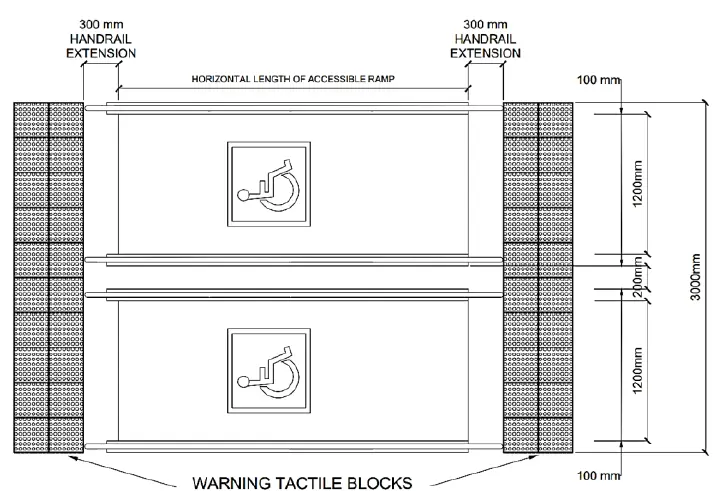
Fig. A.1.4: Ramps & Vehicular Traffic

- Floors and Ground Surfaces
- 1. In all cases, floor surfaces shall be slip-resistant during both wet and dry conditions, level, and stable.
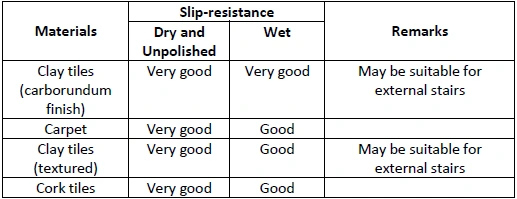
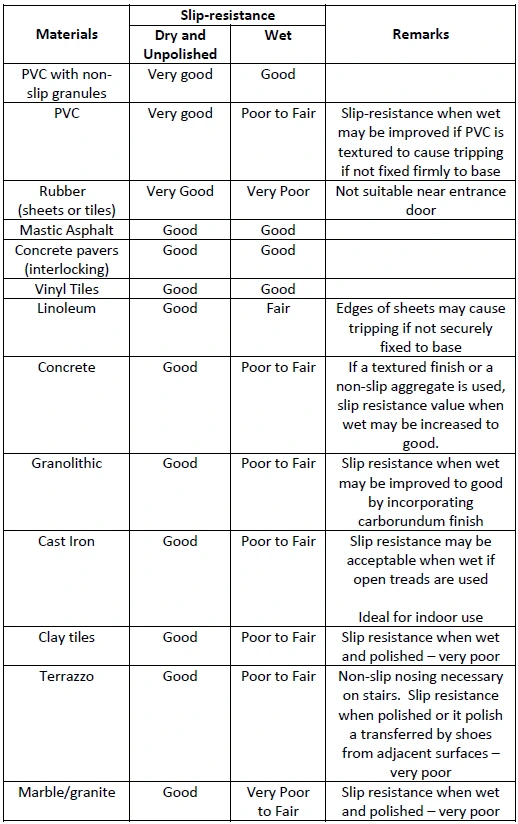
Table A.2.1: Slip Resistance of Typical Flooring Surfaces
(Adopted from Singapore Code on Accessibility in the Built Environment 2019)
- 2. Floor surfaces shall have a minimum luminance contrast of 30% from the adjacent walls. Otherwise, the skirting shall provide a clear distinction between the floor and the wall. (See Isolation Mode)
- 3. Contrasting color bands and detectable warning surfaces shall be employed to alert users of changes in levels.
- 4. If carpets or carpet tiles are used on a floor surface:
- it shall be securely attached;
- have a firm cushion, pad, or backing;
- have a level loop, textured loop, level cut pile, or level cut/uncut pile texture;
- maximum pile thickness shall be 13mm;
- Exposed edges of carpets shall be fastened to floor surfaces and have edge trims along the entire length of exposed edges;
- Channel Covers and Floor Protrusions
- 1. Covers to channels shall be flushed with the surface of the floor, minimizing any height difference that could pose a tripping hazard.
- 2. Holes in the covers shall not exceed 13mm in size.
- 3. There shall be no hazards from floor projections or unexpected changes in level along the accessible path.
- 4. Wiring, outlets, and similar shall not create tripping hazards whether dormant or in use and shall be positioned away from the accessible pathways, corridors and the like.
- Gratings
- 1. Gratings shall be slip-resistant during both wet and dry conditions.
- 2. Gratings shall be level with the surrounding floor.
- 3. Gratings must have a minimum luminance contrast of 30% to distinguish them from the surrounding floor.
- 4. Spacing between grates shall not exceed 13mm.
- Handrails and Grab Bars (See Isolation Mode)
- 1. Handrails shall be required for accessible ramps for changes in grade higher than 170 mm.
- 2. Handrails shall be installed on both sides of ramps and stairs. Handrails may be provided at dropped sidewalks but shall not be installed beyond the width of any crossing so as not to obstruct pedestrian traffic.
- 3. Handrails shall be installed at 900 mm and 700 mm above ramps and stairs.
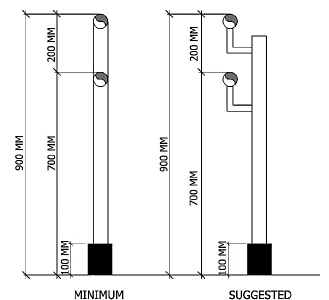
Fig. A.5.1: Handrail Detail for Ramps
- 4. Railings for protection shall be installed at a height of 1100 mm minimum, measured from the top of the rail to the finished floor for stairs, ramps, balconies, landings or porches that are more than 750 mm above adjacent grade. These shall be installed in addition to the handrails required for accessible ramps (Appendix A, Minimum Requirements for Accessibility, Section C Buildings & Structures, Item 2 Ramps). (per NBC Rule XII General Design and Construction Requirements, Guard Rails, f)
- 5. A 300 mm long horizontal extension of the handrail shall be provided before the start and after the end of the ramps and stairs, and shall end with a closed-end that turns down or returns fully to the end post or wall face, without projecting into the travel path.
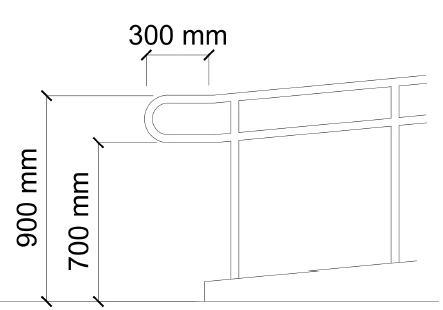
Fig. A.5.2: Cross Section of Accessible Ramp
- 6. Handrails and grab bars that require full grip shall have a round cross-section with a diameter of 1 3/16” (30 mm) to 1 37/64” (40 mm).
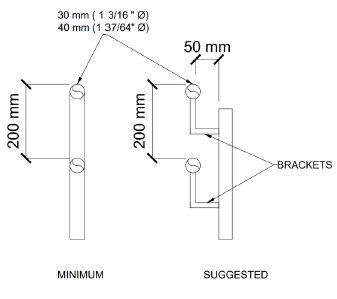
Fig. A.5.3: Handrail Profiles
- 7. Handrails attached to walls shall have a minimum clear distance of 50 mm from the wall. Handrails on ledges shall have a minimum clear distance of 40 mm.
- 8. Handrails shall be continuous throughout the entire length and around landings less than 2100 mm in length, except where it is intersected by an alternative path of travel or has an entry door leading into it.
- 9. Handrails shall be made of slip-resistant material and shall have a continuous gripping surface without any sharp edges or projections.
- 10. The upper handrail extensions, at the top and bottom of stairs and ramps, shall be marked with the destination in Braille accompanied by written characters.
- 11. Handrails shall remain unobstructed. Placing any objects on top of handrails that are not an essential part of the handrail design or do not serve a safety purpose is strictly prohibited.
- Parking (See Isolation Mode)
- 1. Accessible Parking Slot Requirement. Where parking slots are required, the number of accessible parking slots shall be for vehicles driven by persons with disabilities or vehicles with passengers with disabilities and shall be in accordance with Table A.4.1. The passenger with disability shall be inside the vehicle to be allowed to use the accessible parking slots.

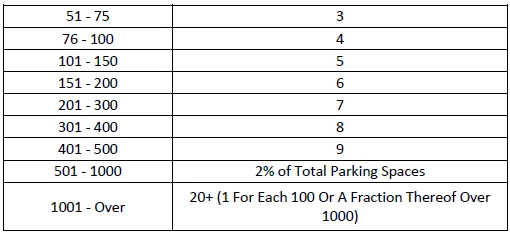
Table A.6.1: Accessible Parking Slot Requirement
- 2. Parking slot for persons with disabilities shall allow enough space for a person to transfer from a vehicle to a wheelchair.
- 3. Accessible parking slot shall be located nearest to accessible main entrances.
- 4. Persons with disabilities shall be on board the vehicle to be able to use the reserved parking slot for persons with disabilities (for control use).
- 5. Access parking placards with the control number and PWD ID shall be conspicuously hung on the rear-view mirror of the vehicle.
- 6. Whenever and wherever possible, accessible parking slots shall be perpendicular or to an angle to the road or circulation aisles.
- 7. Accessible parking slots shall have:
- A minimum width of 4000 mm and a length of 5000 mm. The additional 1500 mm width, in comparison to the average parking slot, is intended to ensure that the adjacent pathway adequately accommodates wheelchair passage. (See Figure A.6.1 below)
- A walkway with a minimum clear width of 1200 mm provided between the front ends of parked cars.
- Dropped sidewalks or curb ramps leading to the parking level where access walkways are raised.
- Pavement markings and fixed pole mounted signage shall be provided between two (2) or more adjacent accessible parking slots.
- Have a firm, level surface without aeration slabs.

Fig. A.6.1: Plan of Accessible Parking Slot
- 8. Parking slots for persons with disabilities shall never be located in ramped or sloping areas.
- 9. For multi-story indoor parking structures, accessible parking slots shall be located right next to accessible elevators, or as close as possible to accessible pedestrian entrances.
- 10. In buildings with multiple accessible entrances with adjacent parking, accessible parking slots shall be dispersed and located closest to the accessible entrances.
- 11. In parking facilities that do not serve a particular building, accessible parking shall be located at the shortest accessible route of travel to an accessible pedestrian entrance of the parking facility.
- 12. For all accessible parking slots, provide the following signage:
- Pole mounted parking signage, 600 mm x 600 mm in size and mounted at a minimum clear height of 2200 mm from the parking floor.
- Pavement sign painted or marked on the designated lot shall comply with the following:
- a square with dimensions of at least 1000 mm but not more than 1500 mm.
- located in the center of the accessible parking space.
- The International Symbol of Access shall be composed of a white symbolized figure of a person in a wheelchair with a square background in UN Blue Color. The symbolized figure shall always face to the right.
- Signage and Wayfinding (See Isolation Mode)
- 1. International Symbol of Access. The International Symbol of Access (ISA) shall be composed of a white symbolized figure of a person in a wheelchair with a square background with United Nations Blue background color or Pantone 279 /#5b92E5.

Fig. A.7.1: International Symbol of Access
The symbolized figure shall always face to the right. Provide directional arrows when the space/area/function being referred to is to the left.
- 2. Audio, Visual, and Tactile directional and information signage shall be located at points that can be conveniently seen, heard, and felt by all persons with disabilities.
- 3. Signage shall be kept simple and easy to understand. Signage shall use contrasting colors and a minimum luminance contrast of 30% from its surroundings to make detection and reading easy. Tactile maps shall be provided to guide persons with visual disabilities.
| Viewing Distance (m) | Size of Symbol (mm) |
|---|---|
| Up to 7.00 | 60 x 60 |
| 7.00 to 18.00 | 100 x 100 |
| Above 18.00 | 200 x 200 to 450 x 400 |
| Required Viewing Distance (m) | Minimum Height of Letters (mm) |
|---|---|
| 1.0 | 10 |
| 3.0 | 30 |
| 5.0 | 50 |
| 10.0 | 100 |
| 20.0 | 200 |
| 30.0 | 300 |
| 50.0 | 500 |
Table A.7.1: Size of Symbol and Height of Letters on Signages
Note: The size of letters should be in proportion to the reading distance.
- 4. The International Symbol of Access shall be used to designate routes and facilities that are accessible in combination with pictographs. Directional signs incorporating the International Symbol of Access, as shown in Figure A.7.1, shall be installed at passageways, and at points where there are changes in direction to lead persons with disabilities to various facilities such as lifts/elevators, entrances, telephone booths, toilets, parking, and the like.
- 5. Shall a sign protrude into a sidewalk/walkway or route, a minimum vertical clearance of 2200m shall be provided. Obstacles, projections, or other protrusions shall be avoided in pedestrian areas such as sidewalks/walkways, halls, corridors, passageways or aisles. Pedestrians with visual disabilities often travel using the edge of the building line, hence, objects mounted on walls, posts, or sides of buildings, shall therefore not protrude more than 100 mm into sidewalks/walkways and corridors.
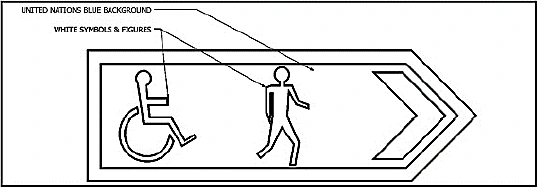
Fig. A.7.3: Typical Directional Signage
- 6. Graphic, text, and Braille signage on walls and doors shall be installed at a
- maximum height of 1500 mm from the finished floor to the center of the sign.
- 7. The size of door mounted signage for accessible toilets and showers shall be 200 mm x 200 mm. General note that wall and door mounted signs shall be not less than 200mm x 200mm in size.

Fig. A.7.4: Mounting Height of Signage on Doors & Walls
- 8. Signage shall incorporate graphics, text, and Braille.
- 9. Signage labeling public rooms, areas, and places shall have tactile symbols, letters or numbers that shall be embossed with a minimum height of 1 mm; Braille symbols shall be incorporated in signs indicating public places and safety route.

Fig. A.7.5: Sign with Embossed Text, Graphics, and Braille
- 10. In addition to International Symbol of Access, signages indicating priority use of persons with disabilities shall be provided at spaces and rooms where priority use of persons with disabilities is required.
- 11. Tactile Floor Surfaces (See Isolation Mode)
- Tactile floor surfaces shall be provided to guide people with visual disabilities.
- Tactile floor surfaces shall be situated at a minimum clear width of 600 mm away from tripping hazards, walls, columns, and other elements that may cause confusion.
- The material shall be slip-resistant and have durable properties under both dry and wet weather conditions.
- Appropriate tactile floor surfaces shall be provided in the following areas:
- Stairways, other than fire exit stairs
- Escalators and elevators
- Passenger conveyors or walkalators
- Ramps other than fire-exit ramps, curb ramps, swimming pool ramps
- In the absence of suitable protective barriers:
- Overhead obstructions less than 2000 mm above floor level
- Areas where pedestrian and vehicular traffic intersect.
- Open spaces
- At other important points and destinations that completes a user route (but not limited to):
- Pathways, sidewalks, corridors
- Entrances and exits
- Security Screening Areas
- Ticket and Information Counters
- Ticket Gates
- Toilets and Restrooms
- Tactile Information Maps
- Accessible Automated Teller Machines (ATMs) and Kiosks
- Platform Screen Doors
- Transit Platforms
- Tactile floor surfaces shall have a minimum luminance contrast of 50% from adjacent floor finishes.
| Feature | Directional Tactile Blocks | Warning Tactile Blocks | Positional Tactile Blocks |
|---|---|---|---|
| Block Size | 300mm x 300mm | 300mm x 300mm | 300mm x 300mm |
| Orientation | Along the direction of travel path | Perpendicular to the direction of travel | Laid at the change in travel direction |
| Number of Raised Elements | At least 4, increasing with tile size | At least 25 (5 x 5), increasing with tile size | At least 25 (5 x 5), increasing with tile size |
| Raised Element Shape | Parallel raised bars | Truncated domes arranged in square grid | Truncated domes arranged in staggered position |
| Raised Element Size | 34mm wide | 35mm diameter | 23mm diameter |
| Height of Raised Elements | 5mm | 5mm | 5mm |
Table A.7.2: Tactile Floor Surfaces
- Tactile paths shall be provided on the primary pedestrian route within 500 meters of and inside the buildings. These paths, shall connect key destinations and can be centrally located to indicate suitability for two-way traffic.
- Security Screening Equipment. At least 1 tactile path shall be provided from the drop-off to the entrance. The tactile path shall guide through the security screening equipment, with warning tactile blocks placed 300 mm before and after the equipment. The path shall be adapted according to the security procedure being implemented.
- Ticketing and Information Counters. At least 1 tactile path shall lead to a ticketing and/or information counter equipped with Braille fare tables and displays. The path branching off shall lead to the ticketing and information counters and be designed in a straightforward manner with minimal distance. Warning tactile blocks shall be installed approximately 300 mm in front of the ticketing and information counter.
- Ticket Gates. The tactile path shall lead to at least 1 ticket gate per direction of the passenger path or at least at one ticket gate which permits passing through all directions, i.e., bi-directional ticket gates. Warning tactile blocks shall also be installed 300 mm before and after the gate.
- Staircases. At least 1 tactile path shall lead to an accessible staircase.
- If stairs lead to different spaces, i.e., stairs leading to different platforms, then each accessible destination shall be provided with a tactile path.
- Warning tactile blocks with a depth of 600 mm shall be installed 300mm from the start and end of the staircase and across the entire width.
- If there is a landing over 3.00 m, warning tactile blocks shall be installed 300 mm from the staircase steps.
- On a landing with a change of direction, warning tactile blocks shall be installed at the start and finish of the landing. If the distance from the turn to the stairs is insufficient,, alternative arrangements shall be made to mitigate the risk of accidents.
- Elevators. The tactile path shall prioritize leading to elevators, which are the preferred means of vertical access for Persons with Disabilities. The path shall terminate in front of the Braille-equipped control panel at the waiting lobby, with warning tactile blocks installed 300 mm before the control panel.
- Escalators. Warning tactile blocks shall be installed on the terminating floor finish preceding the escalator’s metal landing plate. The warning tactile blocks shall have a depth of 600 mm and span the width of the escalator.
- Ramps. Warning tactile blocks with a depth of 600 mm shall be installed 300 mm from the start and end of the ramp and across the entire width.
- On a landing where the ramp changes direction, tactile warning tiles shall also be installed. If the route consists entirely of a ramp, tactile directional tiles shall be installed.
- Accessible Toilets. All tactile paths shall be provided with a path leading to the accessible toilets located along the accessible route.
- The tactile path to the accessible toilets shall lead to the tactile information map, etc., on the wall at the accessible toilet’s entrance/exit. Warning tactile blocks shall be installed 300 mm in front of the tactile information map.
- Tactile information maps, etc. Tactile warning tiles shall lead to a tactile information map near the entrance/exit or ticket gate and be placed 300 mm in front of it.
| Type | Purpose | Description | Placement |
|---|---|---|---|
| Warning Tactile Blocks | Indication of potential hazards ahead and destinations with amenities | Grid Pattern | Warning tactile blocks shall have a depth of 600 mm to ensure detectability and shall be placed perpendicular to the hazard or target object with a 300 mm setback. |
| Positional Tactile Blocks | Indication of possible change in walking directions | Staggered Pattern | Positional tactile blocks shall be provided at the junction of the tactile path to indicate a possible change in travel direction. |
| Directional Tactile Blocks | Indication of intended safe path | Strips | Directional tactile blocks shall be installed along the centerline of the designated travel path, starting from a clear point like an entrance or crosswalk; Use single paths for branching routes to accommodate two-way traffic, avoiding crossing paths for safety and ease. Prioritize simple, direct routes with minimal turns. |
Table A.7.3: Tactile Information Map
- Tactile Maps
- Character Proportion
- Tactile letters and numbers on signages shall have a width to height ratio between 3:5 and 1:1 and a stroke width to height ratio between 1:5 and 1:10
- Raised and Braille Characters and Pictorial Symbol Signages (Pictograms) Letters and numerals shall be raised 0.75 mm, upper case, sans serif or simple serif type and shall be accompanied with Grade 2 Braille. Raised characters shall be at least 16 mm high, but no higher than 50 mm. Pictograms shall be accompanied by the equivalent verbal description placed directly below the pictogram. The border dimension of the pictogram shall be 150 mm minimum in height.
- Finish and Contrast
- The characters and background of signs shall be eggshell, matt or other non-glare finish. Signage shall use light characters on a dark background.
- Character Proportion
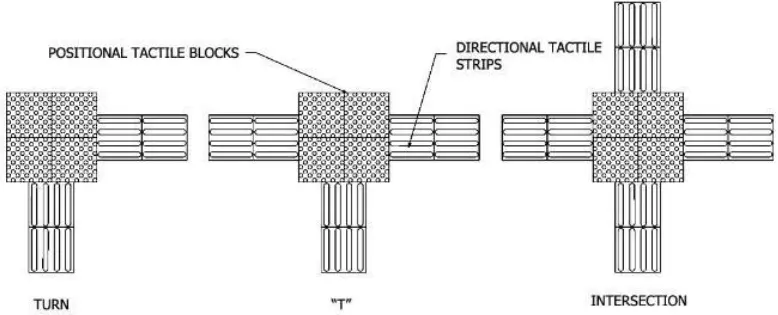
Fig. A.7.6: Sample Usage of Tactile Blocks
- Bluetooth Beacons or Bluetooth Low Energy (BLE) Beacons (Talking Signages)
- Bluetooth Beacons are navigational aids for the visually impaired in large indoor spaces. Bluetooth Beacons assist those with visual disabilities in navigating between any two points within indoor environments by allowing users equipped with smartphones to interact with low-energy Bluetooth-based beacons deployed strategically within the indoor space to navigate their surroundings.
- Hearing Enhancement Systems
- 1. Hearing Enhancement Systems, or assistive listening device, enhance the listening experience of individuals with hard of hearing. These shall be provided in:
- In rooms used for meetings and lectures, function rooms, halls, and auditoriums used for meetings, lectures, performances, or films;
- At least one (1) public information/service counters for cinemas, theaters, concert halls, stadiums, museums, theme parks, purpose-built family amusement centers, sports complexes, public swimming pools, hospitals, clinics, transport stations, interchanges, and passenger terminals.
- 2. Experts shall be consulted when choosing the most suitable hearing enhancement system for specific situations and purposes.
- 3. When hearing enhancement systems are provided to aid individuals who have hearing disabilities, the international symbol of access for hearing loss, as shown in the figure below, shall be conspicuously displayed.
- Stairs (See isolation Mode)
- 1. Complementary ramps, lifts, or escalators shall be provided where staircases are present along an accessible route.
- 2. Uniform risers of 150 mm (maximum) and treads of 300 mm (minimum) shall be used.
- 3. Tread surfaces and nosing shall be slip-resistant in wet and dry conditions
- 4. Nosing shall not protrude. All risers shall have a backward tilt of 25mm.
- 5. Stair nosing shall be durable and slip-resistant in wet and dry conditions with a minimum luminance contrast of 30% to the stair risers and treads.
- 6. Open stringers shall not be allowed.
- 7. A tactile strip (warning tactile blocks) with a depth of 600 mm and with a length spanning the entire width of the stairs, shall be installed 300 mm before hazardous areas or intended stops, such as sudden changes in floor levels and at the top, bottom and intermediate landings of stairs.
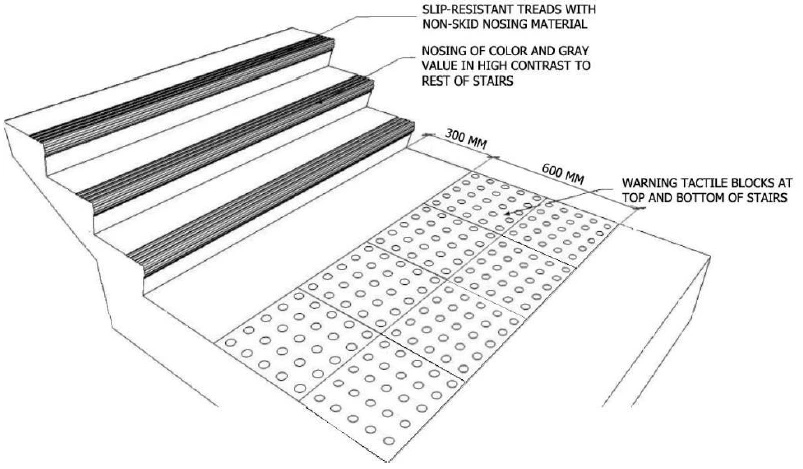
Fig. A.10.1: Location of Warning Tactile Blocks and Non-Skid Nosing Materials at Stairs
- 8. Handrails shall be continuous throughout the entire length of the stairs and shall be provided on both sides of the staircase.
- 9. Handrails shall be installed at 900 mm and 700mm above stair treads.
- 10. The stair handrail shall be bent down at a radius of 150 mm back to the newel post.
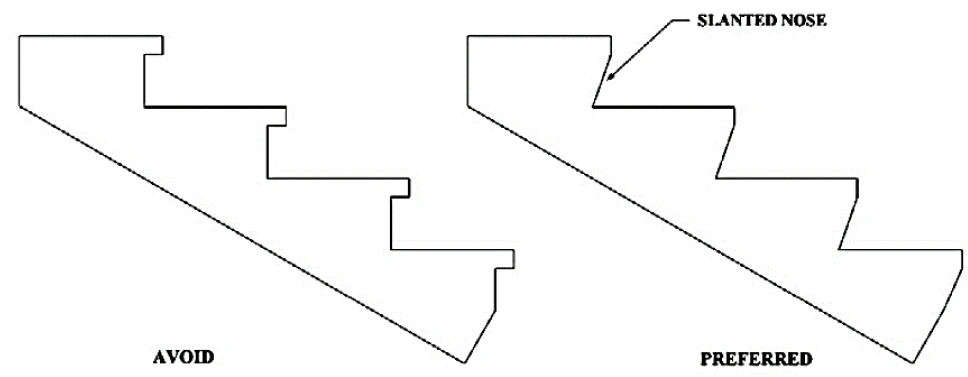
Fig. A.10.2: Stair Nosing
- 11. Adequate lighting should be provided at a recommended level or 100 lux in corridors or on stairways. (See Isolation Mode)
- 12. Braille floor level indicators shall be installed at the end of handrails to indicate what floor level.
- 13. Handrails shall extend horizontally at least 300 mm beyond the first and last step of each flight of stairs and shall end with a closed end that turns down or returns fully to the end post or wall face, without projecting into the travel path.
- 14. Winding and spiral staircases shall not be allowed due to their non-uniform steps. Straight or L-shaped staircases with leveled landings shall be used.
- 15. Accessible staircases shall have a clear width of 1.50m. This minimum width allows for two-way traffic.
- 16. Landings on the stairs shall be provided at a distance where rest is deemed appropriate. Landings shall be provided at intervals of 3 meters or less. Landing depth shall be equivalent to the clear width of the stairs, and shall also be not less than 1500 mm.
- 17. Landings shall not be unobstructed by protrusions such as door swings.
- 18. Adequate lighting shall be provided at a minimum level of 200 lux throughout corridors and on stairways.
- 19. A clear space of at least 1.20m in depth shall be provided before and after a staircase.
- 20. A raised edge with a minimum of 100 mm in height shall be installed on both sides of a staircase except when a wall is in place.
- Surface Materials and Finishes
- 1. Reflective finishes shall be strategically placed along the accessible route to assist individuals with hearing disabilities in perceiving their surroundings. Muted surfaces shall be used in balance whenever possible to support individuals with cognitive disabilities or on the autism spectrum by reducing visual distractions and fostering a calm atmosphere. In acoustically sensitive spaces like theaters, cinemas, and conference rooms, consider alternative accommodations, such as assistive devices or additional signage, for individuals with hearing disabilities.
- 2. Surfaces or features shall have a minimum luminance contrast of 30% to aid individuals with visual disabilities. Consistent luminance contrast levels shall be maintained throughout the facility.
- 3. Simple and uniform patterns shall be used along the accessible route to facilitate understanding and navigation for individuals with cognitive disabilities.
- 4. Surface materials and finishes on walls shall be smooth or shall have trailing bars or handrails in place so that persons with visual disabilities can trail along the walls without difficulties.
- Lighting and Illumination
- 1. Lighting shall be uniform to avoid extreme differences in brightness levels.
- 2. Lights shall be sufficiently bright without causing glare or shadows that could create optical illusions.
- 3. Accessible routes shall have a minimum illumination level of 100 lux. For other spaces, the minimum illumination level may vary according to the latest local codes, such as the Guidelines on Energy Conserving Design of Buildings – 2020 Edition, and the Philippine Electrical Code.
- 4. Controls and operating mechanisms shall be illuminated to a minimum level of 100 lux.
- Protection on Low Headroom Clearance (See Isolation Mode)
- 1. A detectable tapping rail, positioned between 400 mm to 580 mm above the floor, shall be provided in areas with headroom of 2000 mm or less adjoining the accessible route.
- 2. In the absence of suitable protective barriers such as the detectable tapping rail, warning tactile blocks shall be installed to warnpedestrians, especially People with visual disabilities, that they are approaching overhead obstructions.
- Protrusions (See Isolations Mode)
- 1. Obstacles, projections, or other protrusions (e.g., fire hose, extinguisher cabinets) shall be avoided in pedestrian areas such as pathways, sidewalks, and walkways. In cases where protrusions are unavoidable:
- Protruding objects shall not extend more than 100 mm from any wall surface below 2000 mm above the finished floor level.
- Sharp edges are not allowed.
- Objects causing protrusion shall extend to the finished floor level or be guided by tactile flooring with a detectable tapping rail positioned between 400 mm to 580 mm above the floor.
- Protrusions shall not reduce the required clear width for accessible routes.
- OUTSIDE AND AROUND BUILDINGS
- Dropped Sidewalks (See Isolation Mode)
- 1. Dropped sidewalks shall be provided at pedestrian crossings and at the end of walkways of a private street or access road.
- 2. Dropped sidewalks at crossings shall have a width corresponding to the width of the crossing.
- 3. For crossings and walkways less than 1500 mm in width, the base/level surface at the bottom of the ramp shall have a minimum depth of 1500 mm with a width corresponding to the width of the crossing.
- 4. For crossings and walkways less than 1500 mm in width, the base/level surface at the bottom of the ramp shall have a minimum width corresponding to the width of the crossing (4000 mm minimum for national roads and as mandated by Local Ordinances for local roads).
- 5. Dropped sidewalks shall be sloped towards the road with a maximum cross gradient of 1:100 (1%) to prevent water from collecting.
- 6. The difference in elevation between the base/level area of a dropped sidewalk from the road or gutter shall not exceed 19 mm.
- 7. Provide the following signage:
- Pole mounted signage, 600 mm x 600 mm in size and mounted at a minimum clear height of 2200 mm from the sidewalk floor. Pole mounted signs (planted) shall not obstruct the path of pedestrians. {Refer to DPWH Guidelines (Road Signs and Pavement Marking Manual) for installing pole mounted signs on sidewalks.} Pole mounted signs shall incorporate the International Symbol of Access (Please refer to 5.1).
- Pavement sign painted or marked on the ramp complying with the following:
- a square with dimensions of at least 600 mm (for ramps less than 1200 mm wide) but not more than 800 mm (for ramps 1200 mm and wider);
- be located at the center of each ramp;
- Pavement signs shall incorporate the International Symbol of Access (Please refer to 5.1).
- Curb Ramps (See Isolation Mode)
- 1. Curb ramps shall only be allowed when it will not obstruct a sidewalk/walkway or in any way lessen the width of a sidewalk/walkway or lessen the level/turning area of 1500 mm x 1500 mm. Curb ramps shall only be allowed if the width of sidewalks/walkways are more than 3300 mm with a corresponding curb height of 150 mm, otherwise dropped sidewalks shall be used.
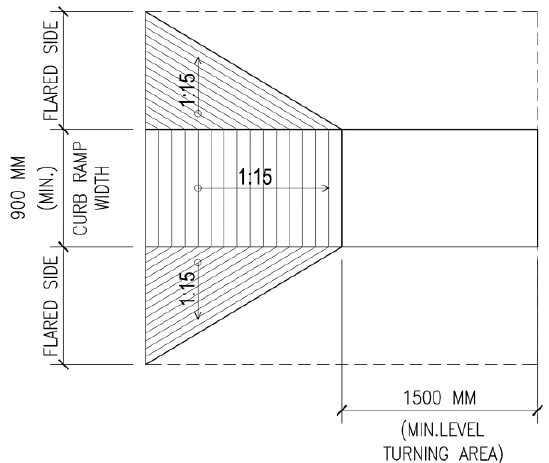
Fig. B.2.1: Plan of Curb Ramp

Fig. B.2.2: Cross Section of Curb Ramp
- 2. For drop off points for persons with disabilities at loading bays, the minimum width of a curb ramp shall be 900 mm.

Fig. B.2.3: 3D View of Curb Ramp
- 3. Curb ramps shall have a gradient not steeper than 1:15. Provide the following signage:
- Pole mounted signage, 600 mm x 600 mm in size and mounted at a minimum clear height of 2200 mm from the sidewalk floor. Pole mounted signs (planted) shall not obstruct the path of pedestrian. (Refer to DPWH guidelines for installing pole mounted signs on sidewalks.) Pole mounted signs shall incorporate the International Symbol of Access (Please refer to 5.1).
- Pavement sign painted or marked on the ramp complying with the following:
- a square with dimensions of at least 600 mm (for ramps less than 1200 mm wide) but not more than 800 mm (for ramps 1200 mm and wider);
- be located at the center of the ramp;
- 4. Pavement signs shall incorporate the International Symbol of Access.
- Pathways, Sidewalks and Walkways (See Isolation Mode)
- 1. The gradient along the length of pathways, sidewalks, and walkways shall be kept as level as possible and shall be slip resistant in both wet and dry conditions.
- 2. Whenever and wherever possible, sidewalks/walkways shall have a gradient not steeper than 1:20 or 5%.
- 3. Sidewalks/walkways shall have a maximum cross gradient of 1:100 or 1%.
- 4. Sidewalks, walkways, and pathways shall have a minimum width of 1500 millimeters. Where space is required for two (2) wheelchairs to pass, the minimum width shall be 1800 mm.
- 5. If possible, gratings shall never be located along sidewalks/walkways. When occurring along sidewalks/walkways, grills of grating openings shall:
- be perpendicular to line of travel
- have a maximum clear spacing of 13 mm between members (each way);
- not be projected nor be recessed more than 6mm above or below level of the sidewalk/walkway.
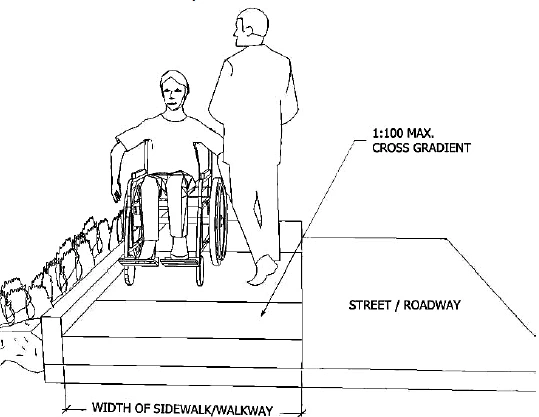
Fig. B.3.1: Sidewalk/Walkway

Fig. B.3.2: Gratings
- 6. Sidewalks/walkways shall have a continuing surface without abrupt pitches in angle or interruptions by cracks or breaks creating edges above 6 mm.
- 7. In lengthy or busy pathways, sidewalks, and walkways, spaces shall be provided at some point along the route, so that a wheelchair may pass another or turn around. These spaces shall have a minimum clear dimension of 1800 mm and shall be spaced at a maximum distance of 12000 mm between rest stops. Turnabout spaces shall also be provided at or within 3500 mm of every dead-end corridor.
- 8. To guide the person with visual disabilities, sidewalks/walkways shall follow straightforward routes with right angle turns.
- 9. Directional Tactile Blocks shall be installed at free and unobstructed walkways/sidewalks/pathways.

Fig. B.3.3: Recommended Use of Directional Tactile Blocks
- 10. Where planting is provided adjacent to the sidewalk/walkway, regular trimming is essential to ensure that branches of trees or shrubs do not extend beyond sidewalks/walkways or paths, as not only do these present a particular danger to the person with visual disabilities, but they also reduce the effective sidewalk/walkway width available to pedestrians in general.

Fig. B.3.4: Walkways with Grass Verge and Edge Protection
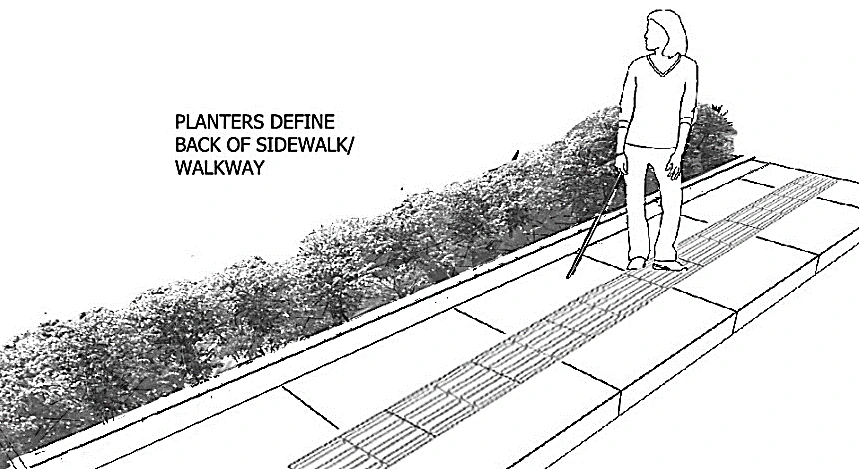
Fig. B.3.5: Walkway with Planters and Edge Protection
- 11. Sidewalk/walkway headroom shall not be less than 2200 mm and preferably higher.
- 12. Sidewalks/walkways shall not be obstructed by street furniture, bollards, signposts or columns electrical utility poles, or telecommunications utility poles along the defined route as they can be hazardous to persons with disabilities. In the presence of support pillars, columns, or other barriers, a minimum clearance of at least 900mm shall be maintained for unobstructed passage.
- 13. For pathways, walkways, and sidewalks using paver blocks provide a minimum 1200 mm wide concrete wheelchair lane.
- 14. Full weather protection shall be provided at entrances and exits, including approaching pathways, sidewalks, and walkways.
- Open Spaces (See Isolation Mode)
- 1. Where open spaces are provided, persons with visual disabilities can become particularly disoriented. Therefore, it is extremely helpful if sidewalks/walkways or paths shall be provided with defined edges either through the use of planters with edge protection, or a grass verge (Fig. B.3.4 & Fig. B.3.5), or similar, which provides a texture different from the path.
- 2. Tactile floor surfaces and markings shall be provided and installed in Open Spaces in accordance to the Signage and Wayfinding section of this IRR
- 3. Where there is a direct drop of 200 mm or more along the access route, an edge protection at least 100 mm in height and 100 mm in width shall be provided;
- 4. Pedestrian-Centric Priority Zones shall be provided in commercial establishments to create a feeling of safety particularly for persons with disabilities.
- Crossings (See Isolation Mode)
- In order to reduce the exposure time to vehicular traffic, all crossings at grade shall:
- 1. Be as perpendicular as possible to the carriageway.
- 2. Be located at the narrowest, most convenient part of the carriageway for mid-block crossings.
- 3. Have a median/island of at least 1500 mm in depth, preferably 2000 mm, provided as a pedestrian refuge, where the width of carriageway to be crossed exceeds 10000 mm or at least 4 lanes.

Fig. B.5.1: Detail of Dropped Sidewalk at Crossing

Fig. B.5.2: Accessible Pedestrian Crossing
- 4. Pedestrian crossings shall not be located at street corners but at a minimum distance of 2000 mm from the corner.
- 5. Provide directional tactile strips in the immediate vicinity of crossings as aid to persons with visual disabilities.

Fig. B.5.3: 3D View of an Accessible Pedestrian Crossing
- 6. Secondary national and local roads with pedestrian crossings shall be provided with light controlled pedestrian crossing signals with synchronized audible pedestrian traffic signals.
- 7. The audible pedestrian traffic signal used for crossings shall be easily distinguishable from other sounds in the environment, to prevent confusion to the blind. A prolonged sound shall be audible to warn persons with visual disabilities that the traffic signals are about to change.
- 8. The flashing green period required for persons with disabilities shall be determined on the basis of a walking speed of 900 mm/sec. rather than 1200 mm/sec., which is what is normally used. The minimum period for the steady green (for pedestrians) shall be the crossing distance times 900 mm/sec. (Refer to Traffic Engineering Center Guidelines for Pedestrians with Disabilities).
- Bollards (See Isolation Mode)
- 1. Bollards along the accessible routes shall have a minimum clear distance of 900 mm between bollards. They shall not be linked with a chain or rope.
- 2. Bollards shall have smooth surfaces, free from protrusions or sharp edges.
- 3. Bollards shall have a minimum height of 800mm.
- 4. Bollards shall have a minimum luminance contrast of 30% from their surroundings. To enhance visibility, provide a reflective band around the neck of the bollard.
- INSIDE BUILDINGS AND STRUCTURES
- Accessible Entrances (See Isolation Mode)
- 1. All public entrances shall be accessible, including entrances that directly serve leased spaces, parking facilities, pedestrian tunnels, and elevated walkways. The term ‘public entrances’ encompasses all entrance points, except those designated as restricted or used exclusively as service entrances.

Fig. C.1.1: Accessible Ramp at Entrance
- 2. Entrances shall be accessible from arrival and departure points to the interior lobby. All entrances and exits along the accessible route shall be designed to prevent longer travel distances or exclusion of Persons with Disabilities from the standard path.
- 3. In case entrances are not on the same level as the site arrival grade, accessible ramps, wheelchair lifts, or similar mechanisms shall be provided as access to the entrance level. The design and construction of ramps shall comply with the specifications outlined in Section A.1. Accessible Ramps of the IRR.
- 4. Entrances with vestibules shall be provided with a level area with at least 1800 mm depth and an 1800 mm width.
- 5. In cases where frameless transparent glass doors and any other vertical transparent glass panels are provided, such glass panels shall have horizontal or graphical patterns with a minimum luminance contrast of 30% against adjacent and background colors, between 800 mm and 1500 mm above the floor to prevent persons with disabilities from bumping against it.
- 6. Accessible entrances and exits of a building, including the stairs, wheelchair lifts, ramps, and other means of access leading to the entrance, shall be equipped with full weather protection to protect persons with disabilities as well as persons without disabilities from rain and exposure to heat.
- Doors (See Isolation Mode)
- 1. All doors shall have a minimum clear width of 900 mm.

Fig. C.2.1: Plan of Sliding Door

Fig. C.2.2: Plan of Swing Door
- 2. Clear openings shall be measured from the face of a fully open door at 90 degrees and the door jamb.
- 3. For double-leaf doors, the minimum clear width shall be 1800 mm.
- 4. Interior door closer devices shall not require the exertion of more than 2.0 kg of opening force, except for fire doors, exterior hinged doors, and devices like latch bolts that keep doors or gates closed.
- 5. The opening force of exterior swing doors can vary due to factors such as wind loading, gasketing, HVAC systems, energy efficiency, and door weight. Often, the force needed for proper closure and latching exceeds the accessible limit for opening force in other doors. Consequently, there is no specified maximum opening force for exterior hinged doors. The installation of automatic exterior doors is preferred, especially when significant opening force is needed.
- 6. A minimum clear level space of 1800 mm x 1800 mm shall be provided before and extending beyond a door;
- EXCEPTION: where a door shall open onto but not into a corridor, the required clear, level space on the corridor side of the door may be a minimum of 1500 mm corridor width.
- 7. Protection shall be provided from doors that swing into corridors.
- 8. Swing-out doors shall be used for storage rooms, closets, toilets and accessible restroom stalls.
- 9. For swing doors, the sweep period of the door shall be adjusted so that from an open position of 70°, the door will take 4 seconds or more to move into a semi-closed position of approximately 12°.
- 10. Latching or non-latching hardware shall not require wrist action, tight grasping, pinching, or fine finger manipulation.
- 11. Door handles, pulls, latches and lever type locksets (doorknob) shall be at 900 mm (centered) above floor finish level.
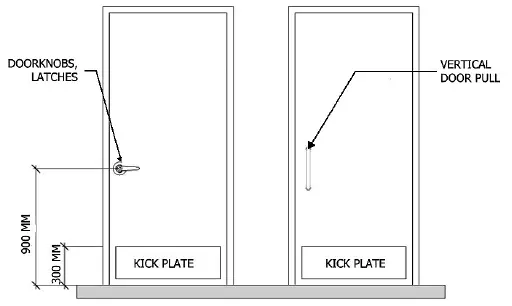
Fig. C.2.1: Door Accessories
- 12. Vertical door pulls, centered at 900 mm above the floor, are preferred to horizontal door pulls for swing doors or doors with locking devices.
- 13. Doors along major circulation routes shall be provided with kick plates made of durable materials at a height of 300 mm to 400 mm.
- 14. For doors with peepholes, provide a secondary peephole at a height of 1000 mm from the finished floor for wheelchair users.
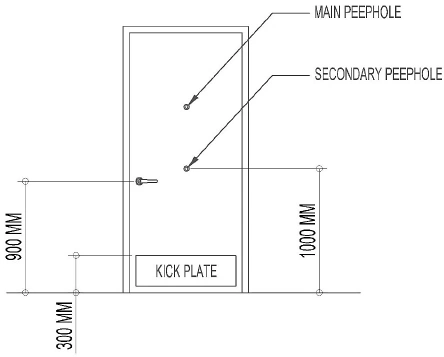
Fig. C.2.2: Door with Dual Peepholes
- 15. Doorways shall be leveled.
- 16. Door hardware, door frames, and doorbells shall have a minimum luminance of 30% compared to their surroundings.
- 17. Sharp edges on door hardware shall be avoided.
- 18. For peep holes and vision panels, the door structure shall enable users to ascertain conditions on the other side of the door.
- 19. Vision Panels shall be installed in all entrances along the accessible paths, unless privacy or security concerns are not an issue. Where vision panels are not suitable, transoms of glass above the door shall be installed to allow subtle senses of movement from either side of the door, or other indicators of rooms being occupied or in use.
- 20. The vision panel shall be installed with a bottom edge not more than 900 mm and a top edge not less than 1500 mm above the finished floor level.
- 21. The width of the vision panel shall not be less than 100 mm.
- 22. For doors with peepholes, provide a secondary peephole at a height of 1000 mm from the finished floor for wheelchair users’ access.
- 23. If a door is a frameless full-height glass door, markings shall be placed across on the glass door such that at least a portion of the marking is placed between 900 mm and 1500 mm above the finished floor.
- The markings or motifs shall consist of two horizontal bands, each at least 100 mm high, and of contrasting colors to assist visibility.
- 24. Manually operated sliding and folding doors shall have operating hardware that is exposed. It also shall have a sufficient gripping surface area from both sides of the sliding and folding doors when fully opened.
- 25. Wherever possible and practical, automatic doors shall be provided for spaces and rooms instead of manually operated doors.
- 26. Automatic doors shall have a sensor delay mechanism to give adequate time for safe passage and for detecting the presence of a person lying on the floor within the door closing area. Automatic doors shall also be capable of manual operation should there be an operational failure.
- 27. If automatic doors are provided with manual button controls to be operated by users, they shall be located adjacent to a clear floor space that has a minimum width of 900 mm and shall be positioned at a height between 900 mm and 1200 mm from the floor level. These manual button controls shall be operable by one hand and shall not require fine finger manipulation.
- Thresholds (See Isolation Mode)
- 1. Thresholds shall be kept to a minimum; whenever necessary, thresholds and sliding door tracks shall have a maximum height of 12 mm and shall be beveled if higher than 6 mm.

Fig. C.3.1: Door Thresholds
- Switches (See Isolation Mode)
- 1. Manual switches shall be installed 900mm to 1200 mm on center above the floor measured from the center line of the switch plate to the finished floor.
- 2. Manual switches shall be located 200 mm on center from the latch side of the door.
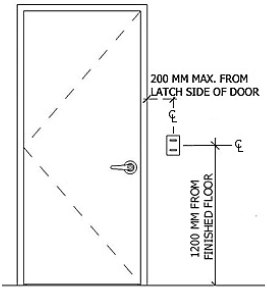
Fig C.4.1: Location of Switches
- Corridors (See Isolation Mode)
- 1. Corridors shall have minimum clear width of 1500 mm to allow a wheelchair user and a person without disabilities to pass.
- 2. Turnabout spaces shall be provided for wheelchairs to turn around; these spaces shall have a minimum dimension of 1800 mm x 1800 mm and shall be spaced at a maximum of 12000 mm.
- 3. Turnabout spaces shall also be provided at or within 3500 mm of every dead-end corridor.
- 4. As in walkways, corridors shall be maintained level and provided with a slip-resistant surface.
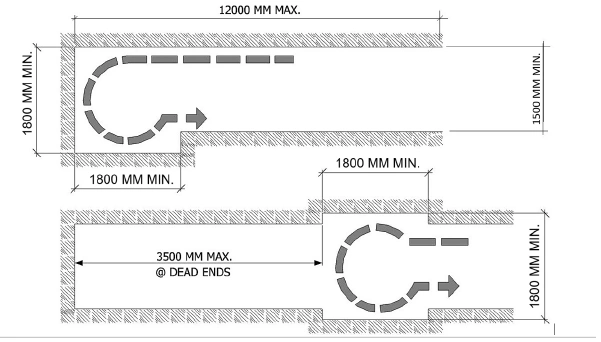
Fig. C.5.1: Turnabout Spaces at Corridors
- Toilets and Baths (See Isolation Mode)
- 1. Accessible toilet facilities shall permit effortless and obstruction-free movement for a wheelchair, enabling the occupant to enter a toilet cubicle or stand-alone toilet, close the door, and transfer to the water closet from either a frontal or lateral transfer.
- 2. On each floor level or area accessible to Persons with Disabilities, there shall be at least one (1) accessible female toilet cubicle and one (1) accessible male toilet cubicle for every 20 or fewer gendered toilet cubicles installed.
- 3. Accessible toilet cubicles shall have the following:
- A minimum area of 1800 mm x 1800 mm
- One fixed L-type grab bar shall be installed on the side wall. The horizontal leg of the L-type grab bar shall begin from the back wall and extend 300 mm from the front of the water closet where the vertical leg will begin and extend to a length of 750 mm above the horizontal grab bar. L-type grab bars shall be anchored at the back wall, at mid span, at the elbow, and at the top of the vertical leg. There shall be a maximum space of 150 mm between the grab bar and the edge of the toilet seat. One flip-up grab bar on the other side of the water closet anchored on the back wall and shall be securely anchored with robust screws, capable of fully supporting a minimum weight of 200 kg. The flip-up bar shall only allow upward and downward movement. The flip-up grab bar shall extend 100 mm from the front of the water closet. Both grab bars shall be installed 300 mm high from the top of the toilet seat to the top of the grab bars. (See Isolation Mode)
- The distance from the outer-face of fixed L-type grab bars to the finished face of walls shall be 100 mm. The clear distance from the face of fixed L-type grab bars to the centerline of water closets shall be 350 mm. The clear distance from the face of flip-up grab bars to the centerline of water closets shall be 350 mm.
- Water closets shall be installed 450 mm from the finished face of the sidewall to the centerline of the water closet. (See Isolation Mode)
- Water closets shall be tank type with lever type flush valves.
- Faucets, shower valves, diverter valves, flush valves of water closets and urinals shall be easily operable without the need for fine finger manipulation and shall be accessible to a person in a seated position.
- All water closet shall have bidet or a flexible hose with spray head for washing and shall observe hygiene protocol for maintenance.
- Water closet seats with a horseshoe-shaped design are prohibited
- A turning space with a minimum dimension of 1800 x 1800 mm for wheelchair users shall be provided outside water closet cubicles.
- The following accessories and fixtures shall be provided in all accessible toilet cubicles: mirrors, paper dispensers, towel racks, handrails, grab bars, bidets, diaper changing tables, faucets mounted at heights reachable by wheelchair users, water closet backrest, emergency call button, baby seat for persons with disabilities with babies. Toilet accessories such as mirrors, towel and soap dispensers, hand dryer, waste bin shall have minimum luminance contrast of 30%. Accessories shall be strategically placed to ensure ease of access for Persons with Disabilities. (See Isolation Mode)
- Accessories and fixtures shall be installed at a height of 1000mm above the finished floor to ensure easy reach.
- Where mirrors are provided, at least one shall be mounted with its bottom edge not more than 1000 mm above the finished floor or shall be tilted to be usable by persons in wheelchairs.
- For lighting/illumination levels, please refer to the latest edition of the Philippine Electrical Code.
- 4. If toilet facility cannot be directly accessed, a turning space of 1800mm x 1800mm and clear transfer space of at least 750mm adjacent to the water closet shall be provided.
- 5. All accessible stand-alone toilets shall have the following: mirrors, toilet paper dispensers, towel racks, handrails, grab bars, bidets, diaper changing tables, accessible toilets, accessible urinal, faucets mounted at heights reachable by wheelchair users, accessible lavatory, and ostomate sink, water closet backrest, emergency call button, strobe light alarm, baby seat for persons with disabilities with babies. Toilet accessories such as mirrors, towel and soap dispensers, silent hand dryer, waste bin shall have a minimum luminance contrast of 30%. Accessories shall be placed near the accessible lavatory.
- 6. All floor surfaces of accessible toilet facilities shall have a minimum luminance contrast of 30% from fixtures to aid people with low vision and other visual disabilities.
- 7. The height of toilet seat shall be 450 mm.
- 8. Lavatories, if provided inside an accessible toilet, shall be installed outside of the 1800 mm X 1800 mm minimum inner to inner clear dimensions of an accessible toilet compartment.
- 9. A lavatory shall be installed at 450 mm distance from center line to adjacent wall. Lavatories shall be mounted at a height of 800 mm from the finished floor with a vertical clear leg room space not lower than 650 mm. A separate lavatory with a height of 550m and a depth of 450mm shall be provided, allowing the spout to be within easy reach for Children and Individuals with shorter stature. (See Isolation Mode)
- 10. An accessible standalone toilet shall have an “occupied” or “vacant” indicator located as close as possible to the door-locking device.
- 11. A call button shall be installed inside and outside the accessible standalone toilet. The locking device of the door shall be used to call the attention of housekeeping personnel. Housekeeping personnel shall be able to respond in less than five minutes.
- 12. Urinals shall be of the wall-hung type and shall have an elongated lip; the maximum height of the lip shall be 350-400 mm from the toilet floor. There shall be a clear, level space of at least 900 mm x 900 mm in front of the urinal. If privacy shields are provided, it shall have a minimum clear width of 750 mm. Urinals shall be equipped with grab bars to provide support while standing. The grab bars shall have a length of 600 mm and be installed on both sides with a clear space of 650 mm between the outer edges of the grab bars. The top edge of these grab bars shall be positioned at a height of 1500 mm above the finished floor level. (See Isolation Mode)
- 13. For every multi-user toilet room installation, there shall be a corresponding accessible stand-alone toilet. This accessible stand-alone toilet shall be separate from the multi-user toilet room, providing specific facilities for persons with disabilities. Accessible stand-alone toilets shall be prioritized to be provided in cases where there are no other types of toilets except single-user toilets. All single-use toilets shall be accessible and gender-neutral to allow for assistance when needed.
- 14. Toilet doors shall be designed to open outwards so that it would be easier for a rescuer to enter a toilet cubicle if the occupant falls and is lying behind the door. To allow for assistance in case of emergency, locks, and latches shall allow the door to be opened from the outside.
- 15. Accessible standalone toilet shall have electromotive or easily operable manual sliding doors that require only light force for operation and are equipped with external emergency unlocking mechanisms.
- 16. An automatic push button door shall be considered wherever possible, since it is easier to operate and maneuver around the doorway.
- 17. Doors of individual accessible toilet cubicles and stand-alone accessible toilets with lavatory shall be provided with a horizontal pull bar fixed at a height of 900 mm. (See Isolation Mode)
- 18. An emergency call button that is waterproof, and of a color that contrasts with the background shall be provided and be located at a height between 400 mm to 600 mm from the finished floor. The emergency call bell, when activated, shall emit an audible or visible alarm signal which shall be readily noticeable for summoning assistance for the person in the accessible toilet. The alarm shall be installed outside the toilet, or a buzzer shall be fitted in the caretaker’s office.
- 19. Strobe light alarms shall only be installed in stand-alone accessible toilet compartments or multi-passenger toilets with accessible toilet compartments to alert persons with hearing disabilities of emergencies requiring evacuation. Specifications and workmanship of strobe light alarms shall be in accordance with the latest edition of the Fire Code of the Philippines. Visible alarms or strobes shall flash not more than 2 flashes per second and in accordance with the latest provisions of NFPA 72.
- 20. Any toilet facility that is equipped with specialized equipment shall prominently display a sign indicating its availability. This ensures that individuals who require the use of such facilities can easily identify and access them.
- 21. The hot water pipes and drainpipes located within the knee space or toe space shall be properly insulated.
- 22. A roll-in shower compartment for wheelchair user shall have a dimension of 1800 mm by 1800 mm and shall have L-shaped bars. Rising butt hinge shall be spiral hinge to close independently. Curbs for roll-in shower shall not be more than 12 mm high and shall be beveled. (See Isolation Mode)
- 23. A shower spray unit & hose with a minimum length of 1500 mm that can be used both as a fixed-position shower head and as a handheld shower head shall be provided.
- 24. Accessible Bathtubs shall have:
- A minimum clear transfer space of 900 mm wide by 1500 mm long.
- two (2) slip resistant grab bars:
- L-Type grab bar with the following minimum dimensions: 1200 mm long horizontal bar installed 250 mm above the rim of the bathtub; 1200 mm long vertical bar installed at the shower side of the bathtub.
- 1200 mm long vertical grab bar shall be installed 250 mm above the rim of the bathtub at the shower side of the bathtub, on the opposite side of the L-type grab bar.
- Shower spray unit & hose with a minimum length of 1500 mm that can be used both as a fixed-position shower head and as a handheld shower head.
- Changing Places (See Isolation Mode)
- 1. At least one (1) accessible changing place shall be provided in areas with extended stays (e.g., airports, healthcare facilities, universities, sports and recreation centers, galleries and museums). Extended stay is defined as any facility where individuals are likely to stay for a duration of 3 hours or longer. This shall be easily located and readily accessible to all individuals.
- 2. Changing Places shall be gender-neutral to allow users to be accompanied and assisted when needed.
- 3. The facility shall be at least 3000 mm x 4000 mm with a ceiling height of at least 2400 mm to ensure that the ceiling hoist system can be used safely for lifting.
- 4. A clear maneuvering space of 2000 mm x 1800 mm shall be provided within the facility to allow adequate maneuvering of wheelchair users. The water closet shall have a clear space of 1800 mm x 1800 mm to facilitate frontal and lateral wheelchair transfers.
- 5. All changing places shall have the following: privacy screen, changing table, ceiling track hoist system that can support at least 200kg, tilted mirrors, paper dispensers, towel racks, handrails, grab bars, bidets, diaper changing tables, accessible toilets, accessible urinal, faucets mounted at heights reachable by wheelchair users, accessible lavatory, and ostomate sink, water closet backrest, emergency call button, strobe light alarm, baby seat for persons with disabilities with babies.
- 6. Toilet accessories such as mirrors, towel and soap dispensers, silent hand dryer, waste bin shall have a minimum luminance contrast of 30%. Accessories shall be placed near the accessible lavatory.
- Elevators (See Isolation Mode)
- 1. Elevators or other means of conveyance to move a user from one-storey to another such as (but not limited to) ramps, platform lifts, or a wheelchair stair lift, shall be provided in buildings for public use.
- 2. All elevators provided in a building shall include suitable provisions for persons with sensory disabilities and ambulant persons with disabilities as a means of access from one level to another.
- 3. All elevators shall be made accessible to persons with disabilities. The location shall be easily identifiable from the main pathway and have a separate area in front to avoid congestion. Where different elevators are programmed to serve certain floors during ordinary or peak periods, the elevator that is designated for persons with disabilities shall be programmed to serve all floors. Highly populated or high occupancy buildings shall accommodate at least two (2) wheelchair users
- 4. Accessible elevators shall be located not more than thirty (30) meters from the entrance and shall be easy to locate with the aid of directional signs. In the case of large public transport facilities (e.g., train stations, airports).
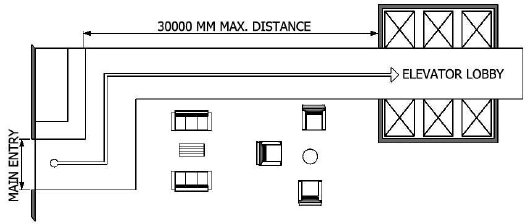
Fig. C.8.1: Distance from Main Entrance to Elevator Lobby
- 5. Accessible elevator cars shall have a minimum clear dimension of 1400 mm in depth and 1200 mm in width, with a clear door opening of not less than 900 mm.
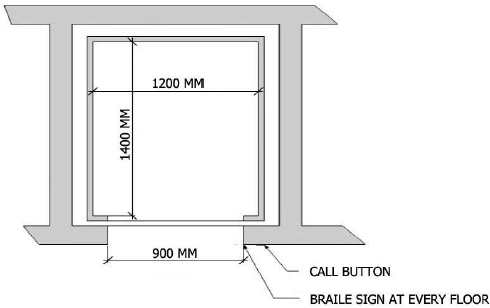
Fig. C.8.2: Plan of Accessible Elevator
- 6. Accessible elevators shall be provided with handrails with the following design specifications:
- Handrails shall be placed at a height of 900 mm from the top of the handrail to the finished floor level;
- Handrails shall be fixed on both sides and at the rear of the elevator;
- Handrails shall have a gap of 150 mm or less if it is not continuous.
- 7. Accessible elevators shall be provided with elevator controls with the following specifications:
- An Accessible Elevator Car Operating Panel (COP) shall be provided and shall be installed at the height of 900 mm on center from the floor.
- All elevator control buttons, including call buttons, emergency and other buttons, shall be provided with Braille installed at the left of the buttons and shall also have tactile buttons.
- Floor level indicators in Braille shall be installed at a height of 1200 mm from the finished floor on both side jambs of the elevator door. This is so that persons with visual disabilities can discern what floor the elevator car has stopped at and what level they will disembark.
- Button sizes at elevator control panels shall have a minimum diameter of 20 mm and shall have a maximum depression depth of 1 mm. (See Figure C.8.5 below)
- The accessible elevators shall have a homing/emergency rescue device.

Fig. C.8.5: Size of Elevator Call Buttons
- 8. Accessible elevators shall be provided with audio, visual, and tactile guide and warning with the following specifications:
- All elevators provided in a building shall include suitable provisions for persons with sensory disabilities and persons with mobility disabilities, as a means of access from one level to another. Provisions for audio, visual and tactile guide and warning shall be provided.
- Accessible elevators shall be provided with voice synthesizers that are clear and easy to understand, for persons with visual disabilities.
- Accessible elevators shall have audio-visual indicators for emergencies for persons with visual and hearing disabilities.
- 9. Accessible elevators shall be provided with an emergency two-way visual communication system through an audio-visual and text based interactive system or video-based interactive system. The emergency two-way communication system shall have audio, visual and tactile control options.
- 10. Accessible elevators shall be operable until any occupants are able to be evacuated in case of power outage.
- 11. Elevators lobbies shall have a minimum clear space of at least 1800 x 1800mm.
- 12. Through-type elevators shall be used when possible. Elevators with entrances/exits in two directions at a right angle shall be a last resort. Exceptions apply only when other types are not feasible, or when the cage is spacious enough to accommodate wheelchair users.
- Platform Lifts and Wheelchair Stair lifts
- 1. General
- For all buildings, a passenger elevator is the most suitable form of access for people moving from one-storey to another. If it is impracticable to provide a passenger elevator or ramp, a platform lift, or a wheelchair stair lift is recommended.
- 2. Platform Lifts (See Isolation Mode)
- A platform lift shall have a minimum clear door opening of 900 mm and clear maneuvering space of minimum 1500 mm wide by 1500 mm deep, measured from the face of the door.
- The minimum internal size of a platform lift shall be 1000 to 1200 mm wide by 1400 mm deep.
- If full height enclosure is not required, the minimum height of the partition shall be 1000 mm
- The platform lift shall be provided with the barrier or flip-up ramp, if a door is not provided, to act as a safety barrier for the wheelchair and serves as an access ramp.
- Lift control buttons shall comply with clauses 7.9.
- f. At least one grab bar shall be placed on a least one side of the lift.
- 3. Wheelchair Stair Lifts (See Isolation Mode)
- A wheelchair lift shall have a minimum clear door opening of 900 mm and clear maneuvering space of minimum 1500 mm wide by 1500 mm deep measured from the face of the door.
- The minimum internal size of a wheelchair lift shall be 1000 to 1200 mm wide by 1400 mm deep.
- If full height enclosure is not required, the minimum height of the partition shall be 1000 mm
- The platform lift shall be provided with the barrier or flip-up ramp, if a door is not provided, to act as a safety barrier for the wheelchair and serves as an access ramp.
- At least one grab bar shall be placed on one side of the lift.
- Escalators and Passenger Conveyances (See Isolation Mode)
- 1. A dedicated downward escalator shall be installed together with an upward escalator, except if users do not simultaneously move in opposite directions.
- 2. The tread width of an escalator shall be at least S800-type (804mm).
- 3. The angle of inclination of an escalator shall not exceed 30°.
- 4. To facilitate the safe transition of individuals with limited mobility onto the moving steps, there shall be a minimum of three steps in the horizontal sections at both ends of an escalator.
- 5. Escalators and passenger conveyors shall be provided with tactile warning strips with a depth of 600 mm installed 300 mm before the floor plates shall be provided at both ends of an escalator or a passenger conveyor.
- 6. Tactile directional shall only be installed for escalators or passenger conveyors with fixed directions. If installed, they shall be placed along with a voice guide, oriented towards the point of entry.
- 7. A voice guidance device shall be installed to notify users of the destination and direction of the escalator or passenger conveyor. The sound source of which shall be installed near the entry point, facing the passenger pathway, ensuring clear audibility amidst ambient noise.
- 8. Escalators for Persons with Disabilities shall have a maximum speed of 30 meters per minute.
- 9. The following parts of the escalator shall have a minimum luminance contrast of 30%:
- Steps
- Comb Plates
- Approach to the Escalator
- Escalator Belt
- Escalator Handrails
- Public Telephones (See Isolation Mode)
- 1. Public telephones shall be equipped with a volume control device.
- 2. Telephones shall have an illumination at a minimum of 200 lux beside the telephone.
- 3. The dialing controls, coin slots, receivers, and instructional signs shall be located at a maximum height of 1200 mm from the finished floor.
- 4. Provide a clear unobstructed space of 1800 mm x 1800 mm in front of wall mounted and free-standing telephones.
- 5. For establishments that provide public telephones Accessible Public phones shall be installed:
- One for each floor
- One for every group of two or more phones.
- Automated Teller Machines (ATMs), Kiosks and Ticket Machines (See Isolation Mode)
- 1. Provide a minimum clear unobstructed space of 1800 mm x 1800 mm in front of ATMs.
- 2. Speech Output. Machines shall be speech enabled. Operating instructions and orientation, visible transaction prompts, user input verification, error messages, and all displayed information for full use shall be accessible to and independently usable by individuals with visual disabilities. Speech shall be delivered through a mechanism that is readily available to all users, including but not limited to, an industry standard connector or a telephone handset. Speech shall be recorded or digitized human or synthesized. Instructions and all information for use shall be made accessible and independently usable by persons with visual disabilities through:
- Braille
- Tactile
- Audio through speakers or earphone jacks
- 3. The height of controls, buttons, bill dispensers, card slots shall be from 900 to 1200 mm.
- 4. Kiosks, ATMs and Ticket Machines shall be installed at a height that is easy to use for wheelchair users and reachable by both standing and seating positions. It is necessary to secure space under the counter to enable wheelchair users to approach ticket machines.
- 5. The input and output devices on the kiosk/ticket machine shall be within reach range and not obstructed by other objects. It shall also be operable without requiring tight grasping, pinching, or twisting of the wrist.
- 6. Counters shall be provided in the kiosks, ATMs, and ticket machines at a height of 750 mm to allow wheelchair users to easily approach. To enable easy operation of the machine by wheelchair users, the space under the counter shall have a minimum depth of about 480 mm.
- 7. Information from these machines shall be communicated properly to all users including people with visual disabilities, individuals who are Deaf or Hard of Hearing.
- 8. Kiosks, ATMs, and ticket machines shall have instructions and all information available through audio output with adjustable volume and shall provide visual instructions, feedback, and prompts that are easily visible from a range of heights and angles.
- 9. An interphone or call button for contacting station staff at times of emergency, breakdown, or inquiry shall be provided.
- 10. There shall be clear signage indicating the location and function of the Kiosks, ATMs, and ticket machines, as well as any instructions for their use. The signage shall be easily visible and located at a height of no more than 2.4m above the floor.
- Dressing Rooms and Cubicles (See Isolation Mode)
- 1. Dressing areas shall have a coat hook installed on a side wall not more than 1200 mm from the floor and projecting not more than 40 mm from the wall.
- 2. Accessible dressing rooms shall have a minimum clear turnaround space of 1800 mm x 1800 mm.
- 3. Accessible dressing rooms shall have a minimum clear door opening of 900 mm and open outward.
- 4. Accessible dressing rooms shall be identified by the International Symbol of Accessibility mounted 1800 mm on center to finished floor at the exterior face of the door.
- 5. Accessible dressing rooms shall have handrails installed 800 mm from the finished floor to top of handrail.
- Accessible Ticket Office Counters and Information Desks (See Isolation Mode)
- 1. All counters shall apply universal design. Two-level counters shall be provided in all customer service and ticketing offices, and information desks. It shall be accessible both in a standing and seating position.
- 2. The lower level of the two-level counters shall have a height of 750 mm, and the higher level shall have a height of around 950 mm – 1100 mm.
- 3. Counters shall have a 700 mm minimum vertical legroom space and shall have a counter depth of 480 mm.
- 4. The clear floor area for a forward approach to a counter or table or a side approach is 1500 x 1500 mm.
- 5. Each counter shall be at least 900 mm wide to provide ample space for people using wheelchairs or mobility aids.
- 6. Clear and visible signage shall be provided with raised letters and Braille to aid People with visual disabilities.
- 7. Hearing Enhancement Systems shall be provided at all customer service and ticket counters, information desks, and alike. This will aid the individuals who are Deaf or Hard of Hearing to ensure effective communication. Hearing Enhancement Systems shall be in accordance with the IRR.
- Workstations (See Isolation Mode)
- 1. Accessible workstations shall account for a minimum of 1% of the total number of workstations available in an office, workspace, or similar environments.
- 2. The access aisle shall have a minimum width of 900 mm.
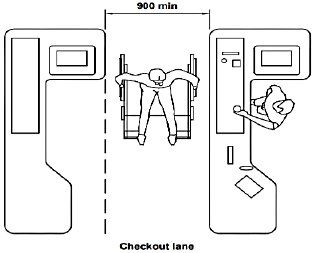
Fig. C.15.1: Accessible Check-Out Counter
- 3. Workstations designed for accessibility shall ensure each desk counter is a minimum of 900 mm wide to provide sufficient space for individuals using wheelchairs or mobility aids.
- 4. These workstations shall include desk counters with a minimum vertical legroom space of 700 mm and a counter depth of 480 mm.
- 5. Workstations shall be equipped with flicker-free monitors to reduce visual discomfort.
- 6. An anti-glare guard shall be installed to minimize screen glare and improve visibility.
- 7. Screen reading software shall be available to aid individuals with visual disabilities.
- 8. Headsets and/or assistive listening devices should be made readily available for individuals who require auditory support.
- 9. Adjustable lighting options shall be provided to accommodate various user preferences and needs.
- Restaurants, Eateries, and other Dining Establishments (See Isolation Mode)
- 1. Provisions of access shall be made available to persons with disabilities for all eating outlets and establishments, such as hawker centers, food courts or centers, fast food outlets, restaurants, and the like.
- 2. A circulation path of at least 1500 mm wide shall be provided in front of the stalls.
- 3. An accessible route with a minimum clear width of 900 mm shall be provided from the circulation path to the tables intended for persons with disabilities.
- 4. Where fixed seating is provided in eating outlets and establishments, ten percent (10%) of the total number of dining table shall be accessible to persons with disabilities. Any fraction thereof is equivalent to one accessible dining table.
- 5. The height of the dining table provided for persons with disabilities shall be 750 mm with a minimum clear knee space of 700 mm high and 480 mm deep.

Fig. C. 16.1: 3D Image of an Accessible Dining Table
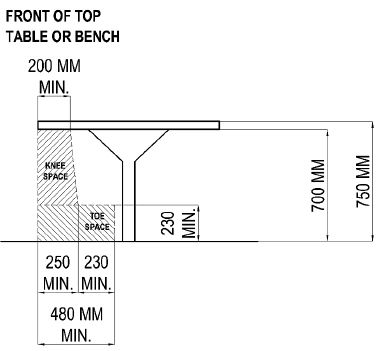
Fig. C. 16.2: Knee & Toe Space of Accessible Dining Table
- 6. Service counters shall apply universal design reachable for persons with disabilities. It shall be a two-level counter design with the lower level having a height of 750 mm and the higher level having a height of around 950 mm-1100 mm.
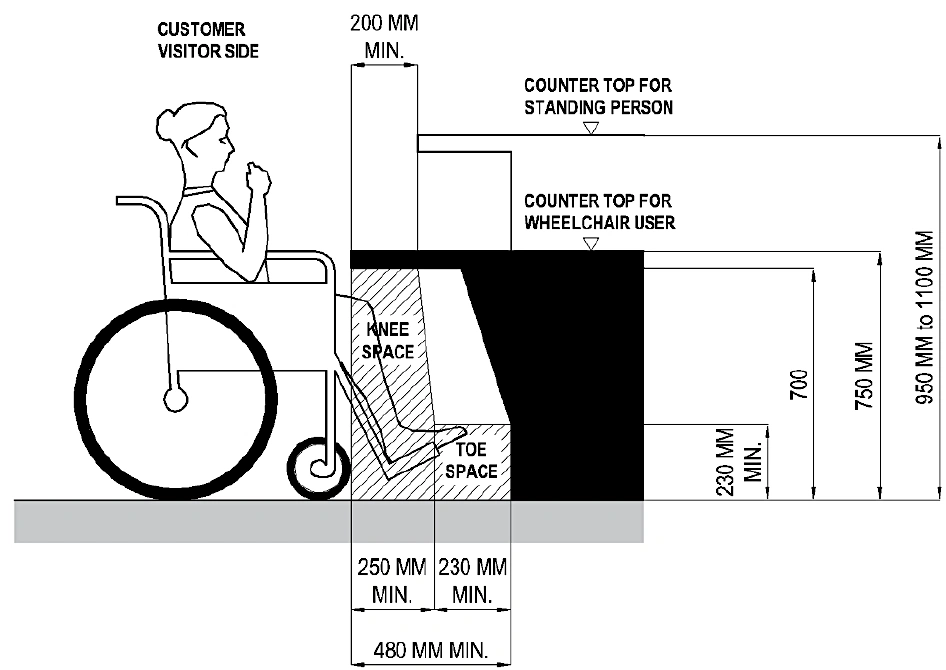
Fig. C. 16.3: Dimensions of an Accessible Service Counter
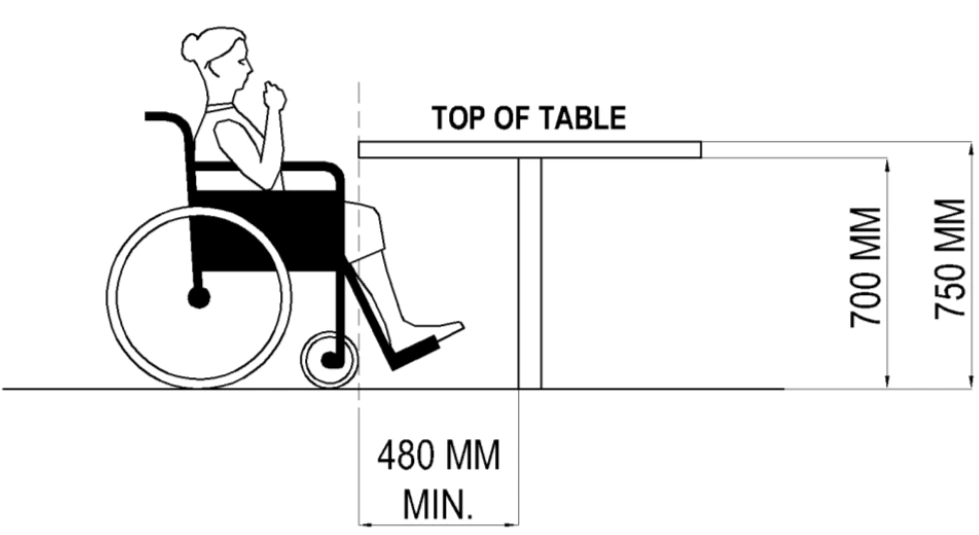
Fig. C. 16.4: Elevation of an Accessible Dining Table
- 7. Directional signs shall be clearly displayed to direct persons with disabilities to the reserved table intended for their use.
- 8. Symbol of access in accordance with Section 5 on signage under General Provisions shall be placed on the table intended for persons with disabilities.
- 9. Where the eating outlet or establishment is provided with fixed seats and tables, the minimum clear space for persons with disabilities shall be 900 mm x 1200 mm. Sizes of fixed tables shall accommodate two (2) wheelchair users.
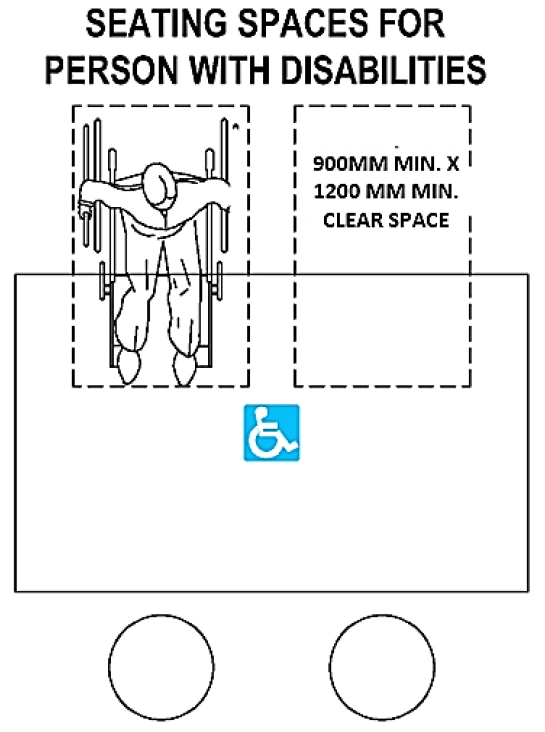
Fig. C. 16.5: Plan of Accessible Seating for Rectangular Tables
- Hotels, Apartelles, Dormitories & Other Transient Lodging Facilities (See Isolation Mode)
Note:
Two percent (2%) or the total number of guest rooms of hotels, apartels, dormitories & other transient lodging facilities shall be Accessible Guest Rooms. Accessible Guest Rooms shall have the following accessibility features and facilities:
- 1. Lever type door handles. Dual height peepholes with the lower peephole installed 1000 mm from the floor.
- 2. Manual switches shall be installed 1200 mm above the floor measured from the center of the switch plate to the finished floor.
- 3. Manual switches shall be located 200 mm from the latch side of the door.
- 4. Electrical outlets shall be installed not lower than of 450 mm from the guest room floor to the center of the electrical outlet.
- 5. Bed shall have a maximum height of 500 mm.
- 6. Easy-to-open doors, preferably sliding closet doors shall be used.
- 7. Adjustable hanger racks or dual height hanger racks with the lower rack installed 1200 mm from the floor.
- 8. Visual warning system consisting of strobe lights supervised, activated, and powered by means of the fire detection and alarm system. Strobe lights shall:
- have a luminous intensity of not less than 2 candelas and produce no more than 3 flashes per second, (NFPA 72)
- have a clear or white translucent lens
- have the word “FIRE” clearly visible on the lens or attached nameplate
- be installed in each:
- bedroom
- room closed off from the living area by a door except a bathroom
- living area or hallway serving the living area
- Comply with all applicable requirements of the latest edition of the Fire Code of the Philippines.
- Staff shall inform and orient guests with disabilities of the locations and functions of the visual warning system.
- 9. Emergency assistance button(s) shall be provided.
- 10. Vibrating Pillow or Bed alarms shall be provided for guests with hearing disabilities.
- 11. Accessible toilets and baths shall comply with the standards and dimensions stipulated in Section 6 on Toilets and Baths.

Fig. C. 17.1: Layout of Accessible One-Bed Guest Room
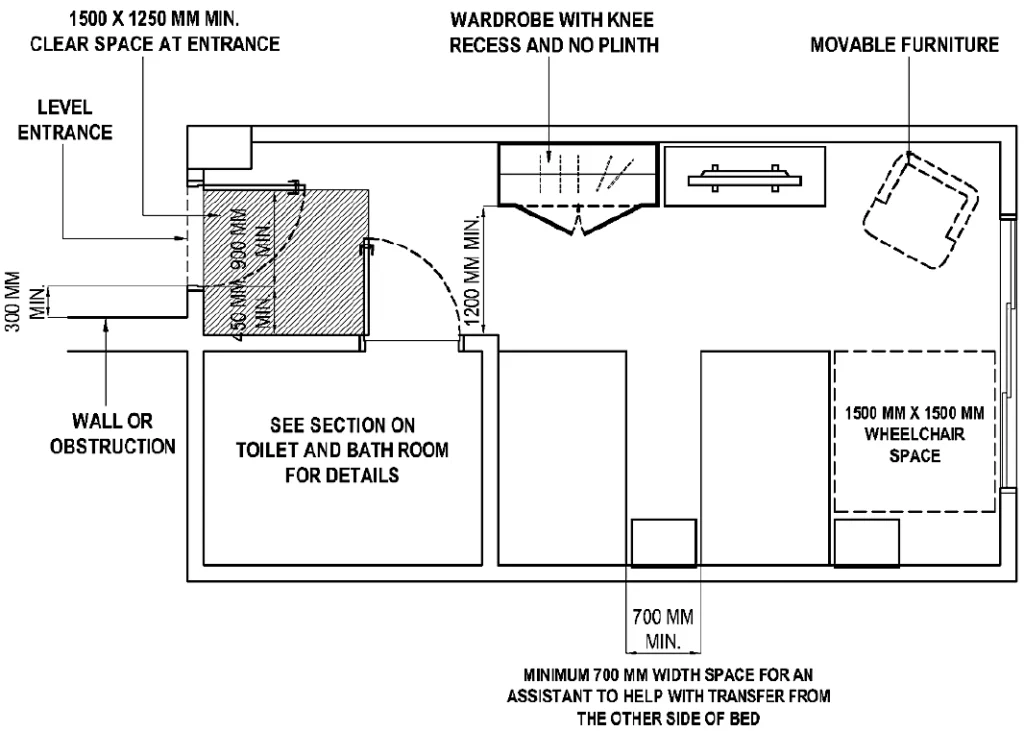
Fig. C. 17.2: Layout of Accessible Two-Bed Guest Room
- Designated Rest Areas and Equipment for Resting (See Isolation Mode)
- In consideration of the long distances entailed in moving around, it is necessary to install equipment for Persons with Disabilities to use for resting.
- 1. Benches
- Staff shall inform and orient guests with disabilities of the locations and functions of the visual warning system.
- One or more benches for resting shall be installed, taking care not to impede the movement of users. If there is a risk that benches may hinder the smooth flow of passengers, it is not necessary to meet this requirement.
- Benches shall be stable and shall be arranged in appropriate intervals, not exceeding thirty (30) meters interval distance, in consideration of users who have difficulty traveling long distances.
- For outdoor rest areas, appropriate shading shall be provided to ensure comfort and protection from the elements.
- 2. Waiting Rooms and Areas
- Layout
- The waiting area shall have sufficient space between seating areas for easy maneuvering of wheelchairs, walkers, and other mobility devices. The waiting area shall have a clear floor space of at least 1800 mm x 1800 mm in front of seating areas to accommodate wheelchair users and their companions.
- The waiting area shall have at least one unobstructed entrance with a clear width of at least 900 mm wide.
- Seating
- The waiting area shall provide a mix of seating options including benches, chairs with armrests, and seats with and without backs.
- Seating shall be arranged to allow for easy transfer to and from wheelchairs.
- At least 5% of the seating shall be designated as priority seating for individuals with disabilities.
- Flooring
- The flooring shall be slip-resistant to prevent accidents and falls.
- The flooring shall be level and free of any tripping hazards.
- Carpeted areas shall have low-pile carpets to allow for easy mobility of wheelchairs and other mobility devices.
- Layout
- 3. Drinking Water Facilities (See Isolation Mode)
- Layout. Where drinking water facilities are provided, access shall be required for wheelchair users and for standing people. Dual access shall be provided in each secured area of a facility equipped with drinking water facilities. At least two units, one reachable for wheelchair users and one for standing people, or a combination of a high-low unit thereof shall be provided for dual access in each such location.
- Drinking water facilities shall be located in an area that is easy to find and access and it shall be marked with appropriate signage.
- The height of drinking fountains shall be 750 mm – 900 mm above the floor and the spout shall be able to extend at least 50 mm from the front edge of the fountain.
- Drinking fountains shall have a clear floor space of at least 1800 mm by 1800 mm in front of and alongside the unit to allow for a person using a wheelchair to access the fountain.
- Drinking fountains shall be automatic or operable with easy-to-use controls, such as a push-button or lever, that can be operated with one hand or a closed fist and does not require fine finger dexterity.
- If a bottle-filling station is included, the spout shall extend at least 100 mm from the front edge of the fountain.
- Clear knee space of 750 mm wide, 200 mm deep, and 650 mm high shall be provided.
- Clear toe space of at least 750 mm wide, 200 mm deep, and 200 mm high shall be provided.
- 4. Breastfeeding Room
- There shall be a designated room for nursing and diaper-changing purposes that is accessible to all. The room shall be furnished with the following items and amenities which shall be accessible to all individuals:
- Anteroom
- Anteroom shall be designed to provide added privacy for the Breastfeeding Room, ensuring that the interior of the Breastfeeding Room is not visible from the outside when the door is opened. It shall be wide enough to fit a stroller and a person side by side.
- Diaper Changing Area
- Baby Bed
- Waste Receptacles
- Stroller Parking
- Sink Area
- Lactation Room
- Baby Bed
- Waste Receptacles
- Rooms shall provide privacy screens or curtains to ensure that individuals can breastfeed in a private and secure environment.
- Sofa or Resting Chair
- Kitchenette
- Grab bars, changing tables, and sinks shall be installed and positioned at an accessible height to accommodate Persons with Disabilities.
- Anteroom
- There shall be a designated room for nursing and diaper-changing purposes that is accessible to all. The room shall be furnished with the following items and amenities which shall be accessible to all individuals:
- 5. Sensory Rooms (See Isolation Mode)
- Sensory rooms shall serve as designated areas where individuals can seek respite and isolate themselves from excessive sensory stimulation. These rooms shall be situated in quiet and private areas, ensuring minimal noise and distractions. It shall be easily accessible and conveniently located on the same level as the main public areas.
- Anteroom
- Anteroom shall be designed to provide added privacy for the Breastfeeding Room, ensuring that the interior of the Breastfeeding Room is not visible from the outside when the door is opened. It shall be wide enough to fit a stroller and a person side by side.
- The room shall be large enough to accommodate a wheelchair, with enough space for a caregiver or support person if needed. A minimum size of 2500 mm by 2500 mm is recommended.
- The doorway shall have a clear width of at least 900 mm wide and shall be easy to open, with no threshold or step. The door shall be designed to allow for access from both the inside and outside in case of emergency.
- The room shall have adequate lighting, both natural and artificial, to provide a comfortable and calming environment.
- The room shall have proper ventilation to ensure a comfortable temperature and fresh air.
- The room shall have comfortable seating, a table or desk, and calming decor. A phone or call button for emergency assistance shall be provided, as well as strobe light alarms for visual emergency indication. Any equipment shall be easily accessible and user-friendly.
- Anteroom
- Sensory rooms shall serve as designated areas where individuals can seek respite and isolate themselves from excessive sensory stimulation. These rooms shall be situated in quiet and private areas, ensuring minimal noise and distractions. It shall be easily accessible and conveniently located on the same level as the main public areas.
- Service Animal Provisions (See Isolation Mode)
- 1. Provide designated spaces for service animals to lie down or rest, with sufficient space for the animal and its owner.
- 2. Provide water bowls in easily accessible locations for service animals to drink from.
- 3. Install weight-activated doors in key pathways that are easy for service animals to operate, with an ideal weight of at least10 pounds to activate the door.
- 4. Service Animal Relief Areas
- The animal relief area shall be located on the same level as the transportation facility or be accessible by an elevator.
- The minimum size for the relief area shall be 3 square meters.
- The relief area shall have an all-weather surface that is slip-resistant, non-toxic, and easy to clean.
- The relief area shall have a sign that displays the international symbol of access for people with disabilities and information on the designated use of the area.
- e. The relief area shall be equipped with a trash receptacle and a means for disposing of animal waste.
- 5. Accommodation for Service Animals in Transportation Facilities
- Service animals shall be allowed to accompany their handlers to any area that is open to the public or where customers are normally allowed to go.
- There shall be no additional fees charged for service animals, and they shall not be required to have identification or certification as a service animal.
- The transportation facility shall only require documentation for the service animal if it is necessary to determine if an animal qualifies as a service animal.
- If a service animal is not allowed to accompany its handler to a specific location, alternative accommodation shall be provided, such as providing a designated waiting area.
- SAFETY
- Fencing for Excavations on Roads and Sidewalks (See Isolation Mode)
- All excavations, whether on the road or footway shall be adequately protected or fenced-in to protect pedestrians in general and persons with disabilities in particular. Whatever the type of fencing used, it is important that the railings shall incorporate the following features;
- 1. The height of the top of the rail shall be at least 1000 mm above the adjacent surface;
- 2. The railings shall incorporate a tapping rail to assist the blind, this shall not be greater than 350 mm above the adjacent surface;
- 3. The fence shall be strong enough to offer resistance should a blind person walk into it;
- 4. Adjoining fence lengths shall be continuous without gaps.
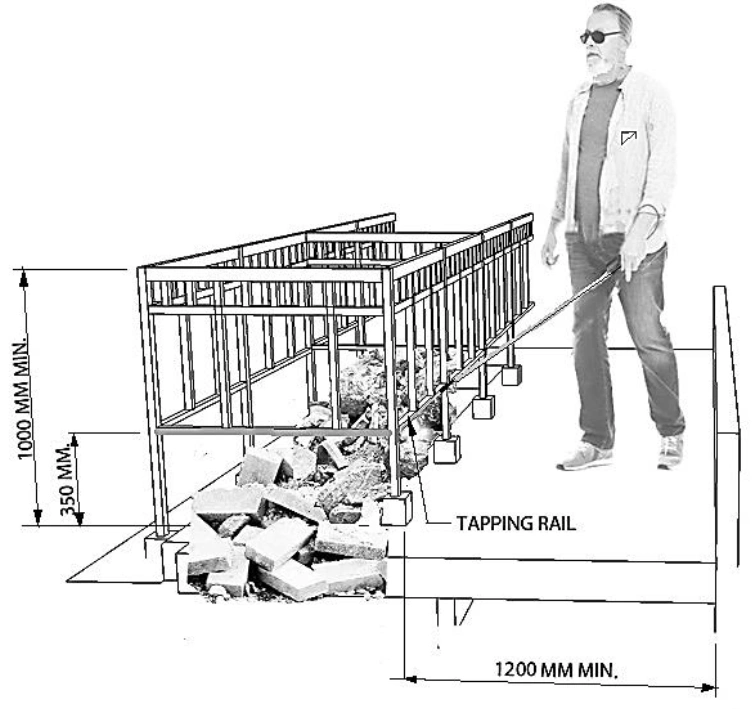
Fig. D.1.1: Protective Barriers Around Excavations
- Covers for Excavations (See Isolation Mode)
- 1. Excavations in the footway or carriageway where pedestrians may walk shall be covered temporarily with properly constructed and supported boards to provide a safe path for pedestrians;
- 2. If the footway width will be reduced to less than 1200 mm because of the excavation, the temporary covering shall extend across the whole footway;
- 3. Minimum dimensions at obstructions
- If a service animal is not allowed to accompany its handler to a specific location, alternative accommodation shall be provided, such as providing a designated waiting area.
- Effective width of footways adjacent to any obstruction shall not be less than 1200 mm.
- If unavoidable, loose materials temporarily stored on footways shall be properly fenced and prevented from encroaching onto the main footway by the use of a kickboard at least 200 mm high which may also serve as tapping board for the blind;

Fig. D.2.1: Protective Barriers with Kickboard
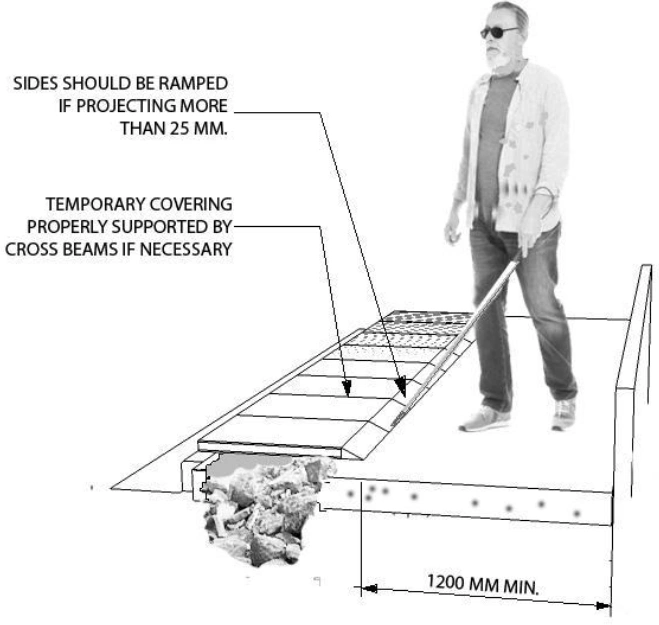
Fig. D.2.2: Protective Barriers with Sloped Edges
- Signage for Roadworks on the Carriageway
- Temporary signs used to warn of roadworks shall be carefully located and shall not cause any inconvenience or obstruction to pedestrians with disabilities. (See Section on Signage and Wayfinding.)
- Location of Emergency Exits
- Wall mounted or free-standing evacuation plans with an embossed floor plan of the building which would also indicate locations of lobbies, washrooms and emergency exits (through the use of different textures to symbolize the spaces) shall be provided at the main lobby of each floor or other strategic locations; the markings on this evacuation plan shall be readable by both the blind and the sighted.
- Areas of Refuge (See Isolation Mode)
- 1. An area of refuge shall be separated from the building floor area by a fire separation having a fire-resistance rating equal to that required for a fire exit in compliance with the latest edition of the Fire Code of the Philippines.
- 2. An area of refuge shall be served by a smoke proof fire exit.
- 3. Refuge areas shall be smoke proof in accordance with latest edition of the Fire Code of the Philippines.
- 4. The minimum dimensions of a refuge area shall be 900 mm x 1200 mm for one wheelchair user.
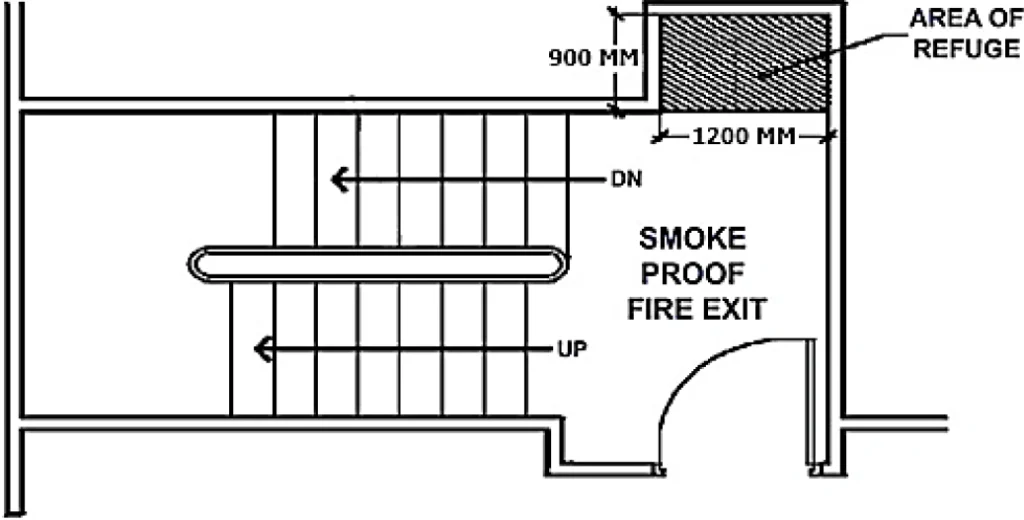
Fig. D.5.1: Area of Refuge
- 5. Areas of Refuge shall be:
- Identified by illuminated signage (Refer to Section on Illumination of Means of Egress of the latest edition of Fire Code of the Philippines).
- The minimum level of illumination of signs shall be 200 lux.
- Equipped with an emergency communication system in compliance with the latest edition of the Fire Code of the Philippines. The emergency communication system shall be installed at a height of 700 mm to 900 mm from the floor and shall be located reachable to the wheelchair users.
- Identified on all public displayed tactile and Braille floor evacuation plans.
- Designated in evacuation procedure documents.
- If possible, provide a smoke extraction system.
- Audio, Visual, Vibrating Fire Alarm Systems (See Isolation Mode)
- 1. Audio and Visual alarm systems shall be installed on all floors in compliance with the latest edition of the Fire Code of the Philippines.
- 2. In sleeping areas, where the mounting height is within 600 mm or less of the ceiling, the required intensity is 177 candelas. When the distance would be more than 600 mm to the ceiling light intensities of 110 candelas may be provided as stated on Section 10.2.6.6 of RA 9514 (Fire Code of the Philippines)
- 3. Notification signals for occupants to evacuate shall be by audible and visible signals in accordance with NFPA 72, or other means of notification subject to the determination and approval of the City/Municipal Fire Marshal having jurisdiction.
- 4. The general evacuation alarm signal shall operate throughout the entire building.
- 5. Provide vibrating pillow alarm for the deaf for hotels, apartelles and resorts in accordance with the International Standard.
- SPECIAL TYPES OF FACILITIES
- Swimming Pools (See Isolation Mode)
- 1. Provide transfer walls with the following features:
- Identified by illuminated signage (Refer to Section on Illumination of Means of Egress of the latest edition of Fire Code of the Philippines).
- The minimum level of illumination of signs shall be 200 lux.
- A clear transfer space of 1500 mm x 1500 mm minimum with a slope not steeper than 1:12 shall be provided at the base of the swimming pool transfer wall.
- The height of the transfer wall shall be 450 mm measured from the top of the transfer wall to the finished dropped deck floor.
- The surfaces of transfer walls shall not be sharp and shall have rounded edges.
- Grab bars shall be perpendicular to the top of the transfer wall and shall extend the full width of the transfer wall.
- Two (2) grab bars shall be provided and spaced at 700 mm clear space in-between.
- The side of the transfer wall serving the transfer space shall be unobstructed.
- Gratings, if required, shall be provided according to section on sidewalks and walkways.
- Transfer walls shall be located at the shallow portion of the swimming pool and shall not be less than 400mm in width.

Fig. E.1.1: Plan of Transfer Wall
(Image Credit: 2010 Americans with Disabilities Act)

Fig. E.1.2: Section of Transfer Wall
(Image Credit: 2010 Americans with Disabilities Act)
- Spas (See Isolation Mode)
- Spas shall be provided with at least one (1) accessible entrance. If spas are provided in a cluster, at least one spa shall have an accessible entrance.
- Sports Facilities (See Isolation Mode)
- 1. Lockers
- If lockers are provided, at least one of each type (full, half, quarter, etc.) shall be accessible and reachable to persons with disabilities. One of each type shall be provided for every fraction thereof. Accessible benches shall be located adjacent to the accessible lockers.
- 2. Benches
- Provide accessible benches in dressing, fitting, and locker rooms, and where seating is provided in saunas and steam rooms. Benches shall have a clear floor space positioned to allow persons using wheelchairs or other mobility devices to approach parallel to the short end of a bench seat. In saunas and steam rooms, this floor space shall not be obstructed.
- Benches shall have seats that are a minimum of 500 mm to a maximum of 600 mm in depth and 1200 mm minimum in length. The seat height shall be 450 mm above the finished floor. If the bench is not located next to a wall, the bench shall have back support that is 1200 mm minimum in length and extends from a point 50 mm maximum above the seat to a point of 450 mm minimum above the bench.
- Benches shall be strong enough to withstand a vertical or horizontal force of 113 kgs applied at any point on the seat, fastener, mounting device, or supporting structure. The provisions for benches are not intended to apply to park benches or other benches used for sitting or resting. If benches are located in wet areas, the surface shall be slip-resistant and designed not to accumulate water.
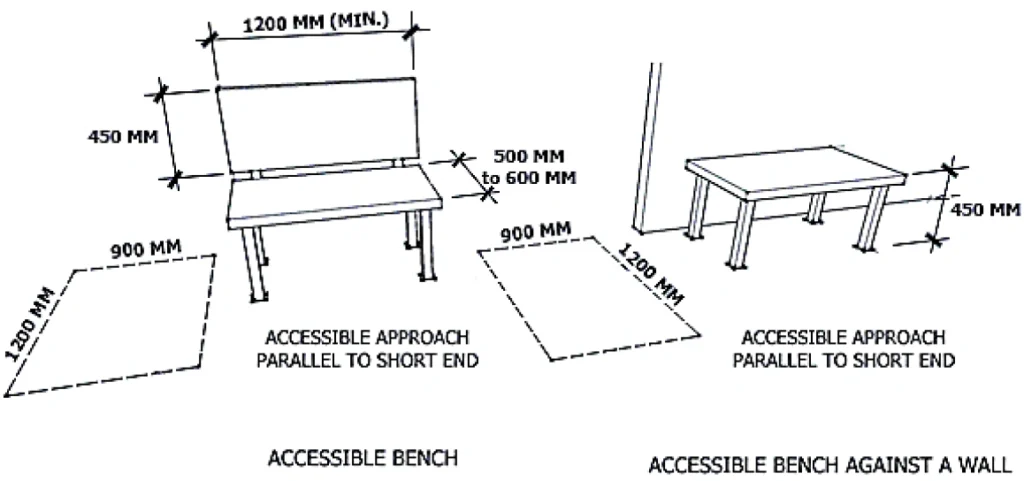
Fig. E.3.1: Clearances around Accessible Benches
- 3. Team Player Seating Areas
- Where provided, fixed team or player seating areas shall contain the number of wheelchair spaces and companion seats (based on the number of seats provided), but not less than one space. One option is to provide a clear space adjacent to a fixed bench, with the bench serving as companion seating. If designers and operators are designing a field or court that will serve a variety of wheelchair sports, exceeding the minimum requirements will better accommodate participants.
- Wheelchair spaces in the team player seating areas are exempt from the requirements related to admission price and line of sight choices in assembly areas. Accessible ramps shall be provided at routes connecting team or player seating areas and areas of sports activities. However, a platform lift may be used as part of an accessible route to team player seating areas.
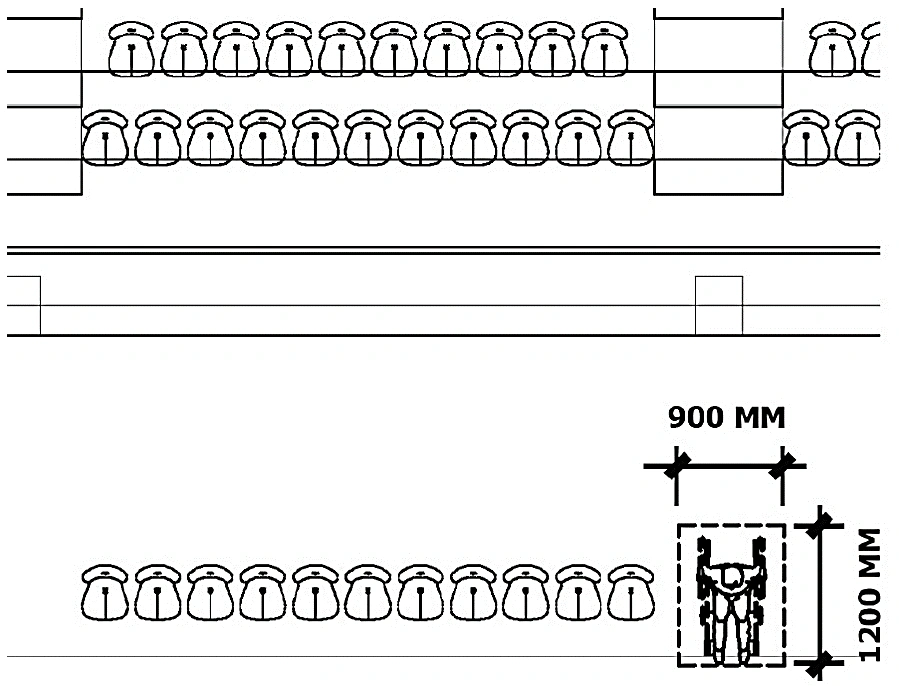
Fig. E.3.2: Accessible Team Player Seating Areas
- 4. Exercise Equipment and Machines
- At least one of each type of exercise equipment or machine shall have a clear floor space of at least 900 mm x 1200 mm and be served by an accessible route. If the clear space is enclosed on three sides (e.g., by walls or the equipment itself), the clear space shall be at least 900 mm x 1200 mm.
- Most strength training equipment and machines would be considered different types. For example, a bench press machine is different from a biceps curl machine. If operators provide both a biceps curl machine and free weights, both shall meet the guidelines in this section even though both can be used to strengthen biceps. Likewise, cardiovascular exercise machines, such as stationary bicycles, rowing machines, stair climbers and treadmills, are all different types of machines. But if the only difference in the equipment provided is that they have different manufacturers, but are the same type, only one must comply.
- Clear floor space shall be positioned to allow a person to transfer from a wheelchair or to use the equipment while seated in a wheelchair. For example, to make a shoulder press accessible, the clear floor space shall be next to the seat. But the clear floor space for a bench press designed for use by a person using a wheelchair shall be centered on the operating mechanisms. Clear floor space for more than one piece of equipment may overlap. For example, where different types of exercise equipment and machines are located next to other pieces of equipment, the clear space may be shared.
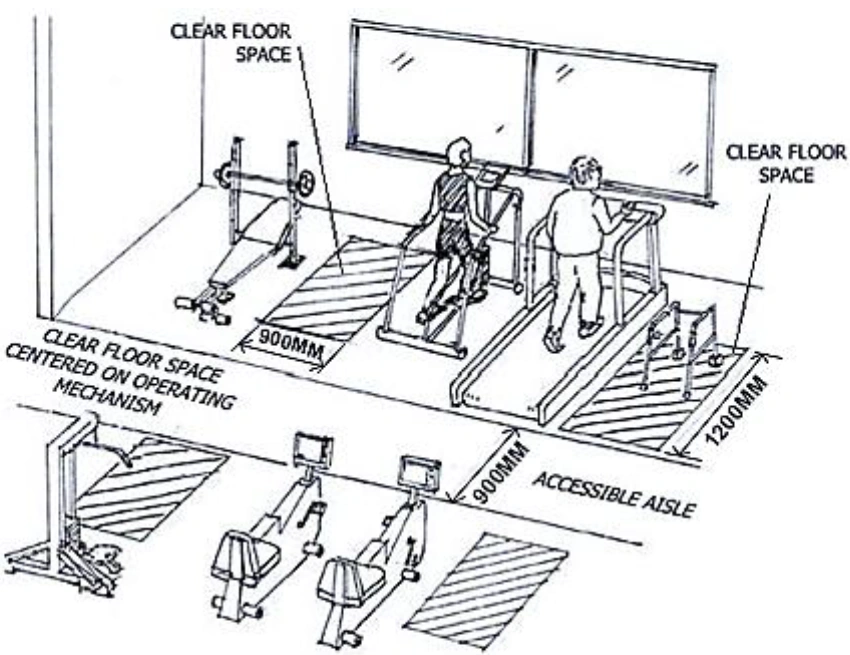
Fig. E.3.3: Clear Spaces Around Exercise Equipment
- 5. Shooting Facilities
- If facilities provide fixed firing positions, at least 5 percent, but not less than one of each type of fixed firing position shall be served by an accessible route. Fixed firing positions shall have a 1500 mm diameter space with slopes not steeper than 1:48 so a wheelchair user can turn around and have a level place from which to shoot.
- Types of different firing positions include positions with different admission prices, positions with or without weather covering or lighting, and positions that support different shooting events (e.g., muzzle loading rifle, small bore rifle, high power rifle, bull’s eye pistol, action pistol, silhouette, trap, skeet, and archery).
- 6. Bowling Lanes
- At least 5 percent, but not less than one, of the total number of bowling lanes shall be accessible. Unlike other areas of sport activity, only those team or player seating areas that serve accessible lanes shall be connected with an accessible route and comply with seating requirements.
- Auditoriums, Arenas, Theaters, and Other Assembly Areas (See Isolation Mode)
- 1. Three percent (3%) of the total seating capacity of auditoriums, arenas, theaters, and other assembly areas shall be wheelchair parking accommodations.
- 2. Accessible routes shall not overlap wheelchair seating or block any waiting spaces.
- 3. Access to any wheelchair space shall not be through another wheelchair space.
- 4. Wheelchair viewing areas shall adjoin accessible circulation.
- 5. Each wheelchair viewing position shall be clear, firm and level. The minimum footprint for a single wheelchair seating space (front or rear entry) shall be 900 mm x 1200 mm.
- 6. It recommended that assistive listening devices be provided.
- 7. Accessible seating shall be provided with handrails 750 mm high at the front and sides.
- 8. Hearing Enhancement System shall be provided in:
- Function rooms, halls and auditoriums used for meetings, lectures, performances or films; and
- At least one of the public information/service counters for cinemas, theaters, concert halls, stadiums, museums, theme parks, purpose-built family amusement centers, sport complexes, public swimming pools, hospitals, clinics, transport stations, interchanges and passenger terminal.
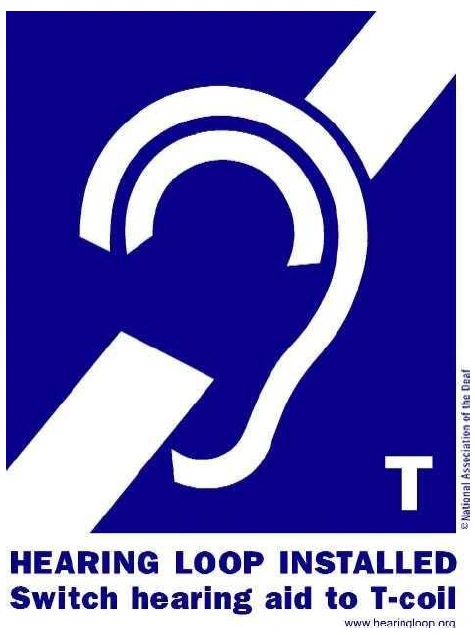
Fig E.4.1: International Symbol for Hearing Enhancement Systems
(Image Credit: www.hearingloop.org.)
- Transportation Facilities
- 1. Pathways and Corridors
- Accessible routes shall be established to connect transportation facilities across various modes of transportation and to all public use buildings and structures within the vicinity, facilitating smooth and effortless transitions both to and from these facilities.
- The minimum width of accessible pathways and corridors along the passenger path shall be 1800 mm. This width shall allow two wheelchair users to pass each other comfortably.
- In cases where support pillars, columns, or other barriers are present, a minimum clearance of at least 900 mm shall be provided to ensure unobstructed passage.
- In addition, full weather protection shall be provided at entrances and exits, including approaching pathways, sidewalks, and walkways.
- 2. Controlled Passage
- For controlled passages that are accessible to the public and are necessary to complete the passenger journey, such as automated fare collection gates, ticket gates, and queuing lines with railings on both sides, each shall have at least one path with a minimum width of 900 mm.
- The controlled passage shall permit passing through to all directions of the passenger path, i.e., bi-directional passage, otherwise a separate passage, one going through each direction available, shall be provided.
- Swing or retractable doors for AFC gates, and equipment alike, are required instead of tripod-type gates and other similar types, that require force prior to passing through.
- The accessible controlled passage shall also be clearly marked with the international symbol of access.
- 3. Automatic Doors
- Wherever possible and practical, automatic doors shall be provided for spaces and rooms instead of manually operated doors. In cases where entrance doors for transportation infrastructure are not held open during operation hours, automatic doors shall be required.
- 4. Platform Screen Doors
- The minimum clear width of a platform screen door shall be 900 mm measured between the face of the door and the face of the door frame to allow independent maneuvering of a wheelchair.
- Tactile Floor Surfaces at Platform Screen Doors
- Warning tactile blocks with a depth of 600 mm shall be installed at least 300 mm before every PSD opening.
- At platform level, all elevators shall lead to a PSD opening.
- At platform level, at least one tactile path from one staircase shall lead to one PSD opening.
- Additional tactile paths on the platform can be determined at the discretion of the designers provided that it shall be installed in a simplified and straightforward manner avoiding confusion.
- 5. Escalators
- Escalators shall be installed on multi-level transport infrastructures especially those serving high passenger volumes.
- There shall always be an alternative pedestrian route provided which shall be located near to, and clearly shown by a sign posted at the entry to the escalator.
- If multiple adjoining escalators are installed, at least one upward and one downward escalator shall be installed.
- Escalators and passenger conveyors in transport facilities shall be installed in accordance with this IRR.
- 6. Elevators
- Accessible elevator cars shall have a minimum depth of 1400 mm and width of 1500 mm, with a clear door opening width of at least 900 mm.
- For horizontal development infrastructure, such as transportation facilities, which cannot attain the thirty (30) meter maximum elevator distance from the entrance provision under this IRR, respite areas shall instead be provided.
- At least two elevators, in close proximity to and shall not be separated from each other by any means of division, shall be available on each floor to service other floors. This is to provide redundancy in case of a breakdown or maintenance. This provision accounts for horizontally separated portions like separate platforms or arrivals and departures on the same level. Elevator placement shall meet the needs of all users, guaranteeing that every relevant area shall be served by an elevator in all situations.
- 7. Respite Area
- Respite Areas shall be provided at every thirty (30) meters or less along the passenger path leading up to the final space prior to boarding in all modes of transportation. These areas shall be properly marked for easy recognition, and priority seating shall be given to Persons with Disabilities.
- Respite Areas shall be in accordance with the Designated Rest Areas and Equipment Section of this IRR.
- 8. Platform Edge to Transit Vehicle
- Boarding platforms shall be leveled with the finished floor of the transit vehicles avoiding noticeable horizontal and vertical gap as much as possible under normal passenger load conditions. If horizontal and vertical gaps between platform edge and the transit vehicle are present, a portable ramp or automatic gap filler shall be provided to assist persons with disabilities in boarding and alighting the transit vehicle.
GENERAL PROVISIONS:
Accessible facilities and features shall be available at all times.
The Metric system is used in all drawings. All dimensions less than ten (10) Meters are in millimeters (mm). All dimension ten (10) meters and greater are in Meter (M).
Ramps are measured in gradient.
GENERAL TERMINOLOGY
Shall – For use in the amendments, shall is used to denote a mandatory specification or requirement.
Should – For use in the amendments, shall is used to express obligation or duty. This denotes an advisory specification or recommendation.
May – Denotes an option or alternative.
In compliance shall be used in all the statements and not in accordance.
For consistency of all measurements used in the amendments mm (millimeters) be used for measurement below 10 meters. For 10 m and above m (meter) shall be used.
DEFINITION OF TERMS
Accessible – A site, building, facility, interconnection or any portion of the built environment that can be approached, entered and used by persons with disabilities; refers to features that enable persons with disabilities to make use of the primary functions for which a building/structure is built.
Access Aisle – Clear circulation route bounded by moveable furniture that can be negotiated safely by persons with disabilities
Accessible Design – Creating environments that are approachable and useable by people with disabilities; Unhindered, without obstructions to enable persons with disabilities free passage or use of the facilities.
Accessible Entrances – An accessible path leading to the entrance of the building, must be level or have a curb ramp.
Accessible Parking – Parking spaces which are useable by persons with disabilities.
Accessible Route – A continuous, unobstructed path connecting all accessible elements and spaces of a building/structure or facility that can be negotiated safely and independently by persons with disabilities. Accessible routes shall not incorporate any step, drop, stairway, turnstile, revolving door, escalator or other impediment which would prevent it from being safely negotiated by persons with disabilities. Interior accessible routes shall include doorways, corridors, floors, ramps, lifts and clear floor spaces at fixtures. Exterior accessible routes shall include parking access aisles, ramps, sidewalks, walkways and pedestrian crossings.
Accessible Route Plan – Plans showing the accessible routes to the building from adjacent buildings and nearest public facilities as well as accessible routes within the building.
Accessible Units – The various provisions and facilities integrated into buildings and surroundings to cater to the needs of Persons with Disabilities.
Alcove – A small, recessed space in a room or wall.
Ambulant Person with Disability – A person who is able, either with or without personal assistance, and who may depend on prostheses (artificial limbs), orthoses (calipers), sticks, crutches or walking aids, to walk on level or negotiated suitably graded steps provided that convenient handrails are available.
Anthropometrics – Pertaining to the measurement of the human body.
Area of Refuge – An area which has direct access to an exit, separated from the general floor area by a fire separation having a fire-resistance rating at least equal to that required for an exit that is smoke protected and served by an exit or a fireman’s elevator. It is an area where persons with disabilities who are unable to use the stairs may remain temporarily in safety to await further instructions or assistance during emergency evacuation. It shall have a minimum space of 900 mm X 1200 mm per non-ambulant person with disability, with a minimum of 2 spaces.
Barrier-free – The design and construction of spaces and structures without obstacles or impediments, enabling unrestricted access for individuals, irrespective of their physical capabilities or disabilities.
Bidet – A flexible hose with hand spray head attached to the water closet angle valve as used for washing the vital body parts.
Bollard – A low post used to segregate a pedestrian path from vehicular traffic.
Building – Constructed structures and associated facilities, with a focus on ensuring safety, purpose, proper construction, and maintenance, all in accordance with established regulations and definitions.
Clear – Unobstructed
Clear Floor Space – The minimum unobstructed floor or ground space required to accommodate a single wheelchair user.
Corridor – A passageway providing access to several rooms or spaces to an exit.
Curb – A raised rim of concrete, stone or metal which forms the edge of a street, sidewalk, ramp, planted area, etc.; Side barrier to a trafficable surface.
Curb Ramp – A break in the sidewalk or traffic island provided with an inclined surface to facilitate mobility of persons with disability; sloped area cut into a curb.
Short ramp cutting through a curb or built up to it.
Door – An entranceway which swings, slides, or folds to close an opening in a wall or the like.
Dropped sidewalks – the lower portion of the sidewalk adjacent to at least one accessible ramp and the street gutter.
Edge protection – a safety measure in the form of guardrails and handrails.
Egress – An exit, or a means of going out.
Elevator – A hoisting and lowering mechanism equipped with a car or platform which moves in guides, in a vertical direction serving two or more floors of a building or structure.
Entrance – Any access point to a building or facility used for the purpose of entering; An entrance includes the approach walk, the vertical access leading to the entrance platform, the entrance platform itself, vestibules if provided, the entry door(s) or gate(s), and the hardware of the entry door(s) or gate(s).
Facility – All or any portion of buildings, structures, site improvements, complexes, equipment, roads, walks, passageways, parking lots, or other real or personal property located on a site.
Flare – A sloped surface that flanks a curb ramp and provides a graded transition between the ramp and the sidewalk. Flares bridge differences in elevation and are intended to prevent ambulant persons with disabilities from tripping. Flares are not considered part of the accessible route.
Floor – The surface within a room or area on which one walks.
Grab Bar – Graspable bar used to give a steadying or stabilizing assistance to a person engaged in a particular function.
Gradient of Ramp – The degree of inclination of the sloped surface expressed as a percentage or ratio.
Graphic Sign – A drawing, painting, diagram, engraving, etching or other similar illustrations which from a single glance conveys a given message; a visual aid.
Guard – Protective barrier to prevent accidental falls at openings in floors and at the open sides of stairs, landings, balconies, mezzanines and ramps. Handrail supports often act as guards.
Handrail – A rail used in circulation areas such as corridors, passageways, ramps and stairways to assist in continuous movement. A hand support along a stairway or ramp consisting of rails, their supporting posts, balusters or pillars and constituting an enclosure or a line of division.
Height Above Floor – Distance between two points aligned vertically with one of the points on the floor.
Individual Washroom – A compartment having the basic requirements of a water closet compartment, wash basin and other essential washroom accessories as required by persons with disabilities.
Ingress – an entrance or a means of going in.
Infrared System – Specialized sound system that converts sound into infrared light; the lights are reconverted into sound by a portable receiver.
Luminance Contrast – Occurs when there is not only a contrast in color between a surface and its background, but there is a luminance factor to the surface which provides a slightly reflective quality, further highlighting an area from the background.
Multiple Leaf Doors – Two or more doors separated only by a door frame. Each door is called a leaf.
Nosing – Overhanging edge of a stair tread, usually half rounded.
Obstacle – An object that limits the vertical passage space, protrudes into the circulation route, or reduces the clearance width of a sidewalk or trail.
Operable Part – Pat of a piece of equipment or appliance used to insert or withdraw objects or to activate, deactivate, or adjust the equipment or appliance (for example, coin slot, push-button, handle).
Parking Area – Allocated space composed of marked-off portions for single motor vehicles on a short-time storage basis.
Parking Slot refers to Parking Space
Passageway or Passage – A space connecting one area or room of a building with another.
Pedestrian Crossing – a marked part of a road where pedestrians have right of way to cross; a crosswalk.
Persons with Disabilities – Persons with Disabilities include those who have long-term physical, mental, intellectual or sensory impairments which in interaction with various barriers may hinder their full and effective participation in society on an equal basis with others. (UN-CRPD).
Place of public resort – A building or a defined or enclosed place used to constructed or adapted to be used ether ordinarily or occasionally as a church, chapel, mosque, temple or other place where public worship is or religious ceremonies are performed, not being merely a dwelling house so used, or as a community club, country club, or as a cinema, theatre, public exhibition/concert/lecture hall, public ballroom, museum, stadium or as a public race of assembly for persons admitted thereto by ticket or otherwise or used or constructed or adapted to be used either ordinarily or occasionally for any other public purpose.
Positional Tactile Block – Indication of possible change in walking directions.
Principal Entrance – An entrance used most frequently by the public and building occupants.
Public-use Buildings – Structures accessible to the general public, whether privately or publicly owned, providing spaces available for communal use. These spaces encompass various facilities, such as government offices, educational institutions, healthcare centers, and recreational venues.
Public Telephones – A shelf-unit telephone with coin operating functions for the use of the public.
Ramp – Any slope greater than 1:20 (5%). An inclined way connecting one level to another; A sloped surface connecting two or more planes at different levels.
Riser – Vertical portion of a step.
Run – Horizontal distance of a stair or ramp.
Roll-in Shower – To be used while staying in a wheelchair, standing, or sitting (by adding a seat to the shower stall).
Sidewalk – A paved foot walk at the side of a street or roadway.
Signage – Displayed verbal, symbolic, tactile, and pictorial information.
Site – A parcel of land bounded by a property line or a designated portion of a public right-of-way.
Slip Resistance – the relative force that resists the tendency of the shoe or foot to slide along the walkway surface. Slip resistance is related to a combination of factors including the walkway surface, the footwear bottom, and the presence of foreign materials between them.
Slope – The slope of a ramp is expressed as the height to the length (i.e., 1:16 indicates for each 1 m in height, there is 16 m in length).
Space – A definable area i.e., room, toilet, hall, assembly area, entrance, storage room, alcove, courtyard, or lobby.
Symbol – The International Symbol of Access for persons with disabilities.
Tactile – Describes an object that can be perceived using a sense of touch.
Tactile Warning – A change in surface condition that provides a tactile cue to alert pedestrians of a hazardous situation.
Tactile Signs – Signs having raised letters which are interpreted or read by tracing with fingers over the surfaces.
Tactile Floor Surfaces – Textured floor finishes also known as truncated floor finishes, detectable warning devices, blistered surfaces that can be used as non-skid materials. Referred to as warning, positional, and directional blocks to warn visually impaired persons of danger or indicate facilities besides, or an indicator to make a turn in direction.
Terminal – Passenger and freight loading/unloading spaces and ancillary spaces (such as parking slots, waiting areas, driveways connecting such spaces, access systems, etc.) for use by public motor vehicles.
Threshold – A strip fastened to the floor beneath a door, usually required to cover the joint where two types of floor materials meet; may provide weather protection at exterior doors.
Toilet – A room containing various toilet compartments with at least one wall-hung lavatory and one water closet compartment.
Toilet Stall – a small enclosed private area for washing or using a toilet.
Transient Lodging – A building, facility, or portion thereof that contains sleeping accommodations that may include resorts, group homes, hotels, motels, and dormitories.
Truncated Domes – Small domes with flattened tops that are used as tactile detectable warning indicators at transit platforms, vertical drops and curb edges.
Universal Design – The design of products and environments to be used by all people, to the greatest extent possible, without the need for adaptation or specialized design. Concept used to create environments that respond to the widest range of the population possible.
Vestibule – A small entranceway or transitional space for the exterior to the interior of a building and opens into a larger space.
Visual Warnings – The use of contrasting surface colors to indicate a change in environment, such as at a curb ramp where the sidewalk changes to the street.
Walk – An exterior pathway with a prepared surface intended for pedestrian use.
Walkway – An exterior passage for walking along, especially one connecting adjoining buildings and related structures.
Warning Tactile Blocks – A standardized tactile surface feature built in or applied to walking surfaces or other elements to warn visually impaired people of upcoming hazards. (Often a paver insert composed of tactile raised truncated domes, applied perpendicular to the hazard.)
Washroom – A room providing facilities for washing; a lavatory or toilet room.
Water Closet – A room or booth containing a toilet and often a washbowl.
Water Closet Compartment – A compartment having a water closet with grab bars installed to assist persons with disabilities.
Water Fountain – A fixture consisting of a shallow basin, together with a water jet designated to provide potable water for human consumption.
Wayfinding – The process of planning, deciding, and navigating through a space to reach a destination, using cognitive and physical elements.
Wheelchair User – A person with disability who depends on a wheelchair for mobility; A person with disability who is not able to walk on level or suitably graded steps.
Width – The clear distance from one finished surface to another.
Width of Corridor – The linear width of the unobstructed path in corridors
Winder – Tread wider at one end than the other, as in circular stairs.












